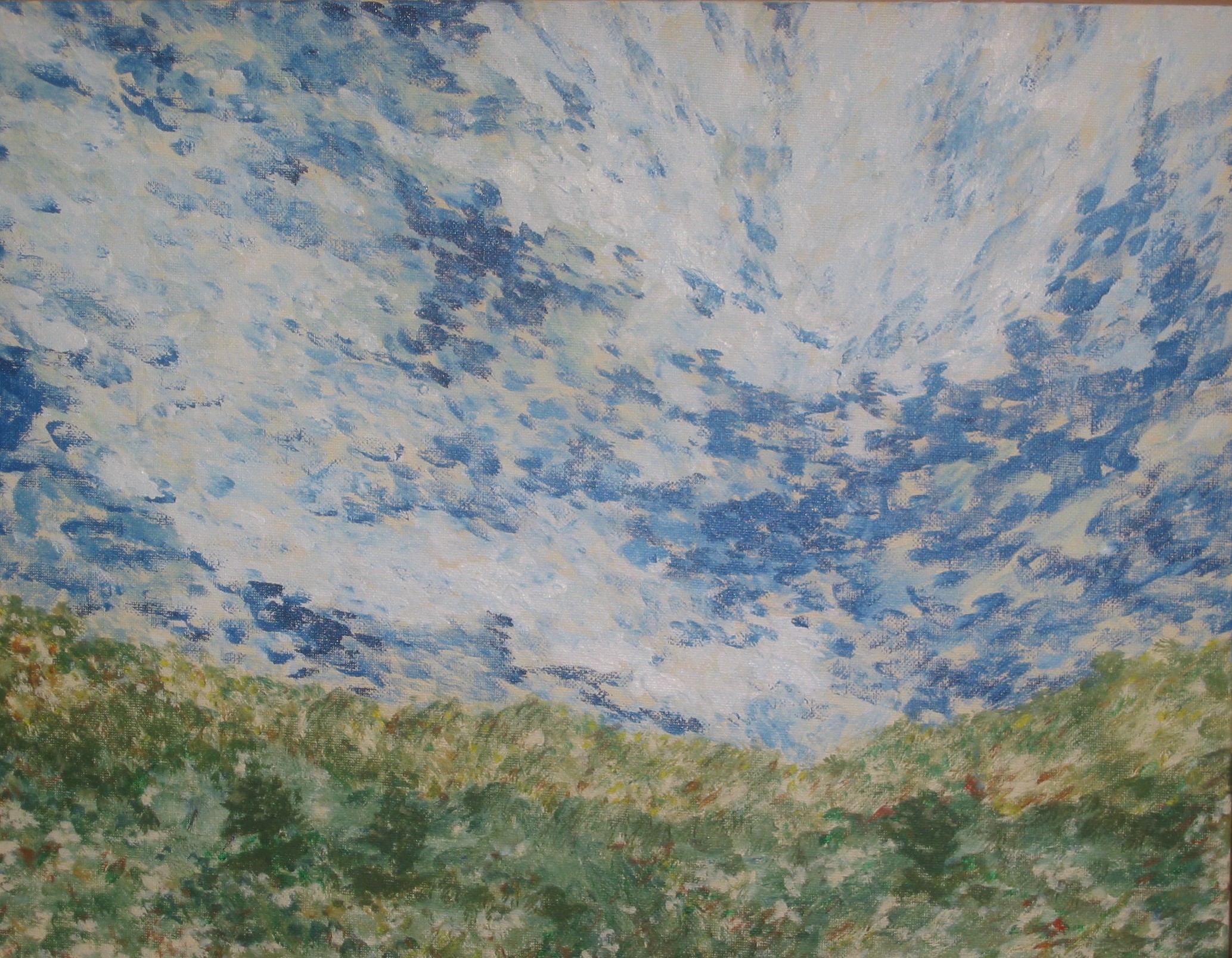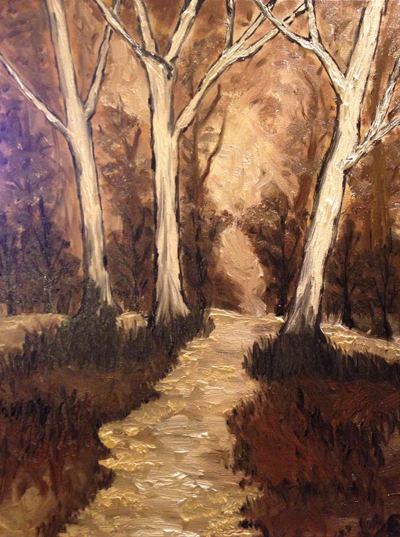FEATURED MEMBERS
The American Art Therapy Association represents a diversity of professionals, students, and organizations across the nation. We recognize and celebrate the work of our members at all levels through our Featured Member series.
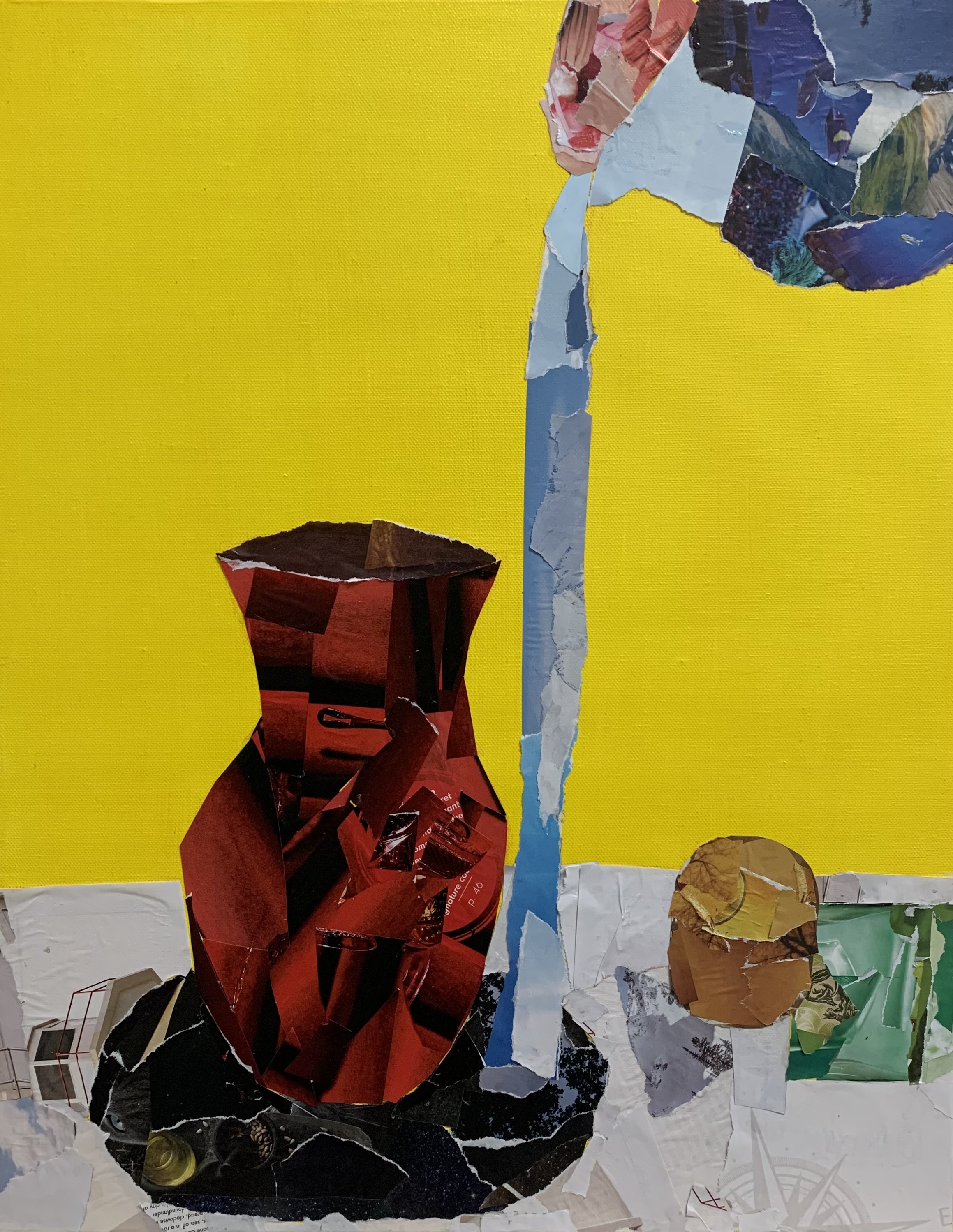
"The Therapeutic Relationship” by Kaalex Ash-Green.
Collage and acrylic on canvas. 12/6/2021.
“This piece depicts a plant being “bottom watered” by absorbing water poured from a pitcher into the basin the plant is resting in. It is a metaphor for the therapeutic alliance between an art therapist and their patient.”
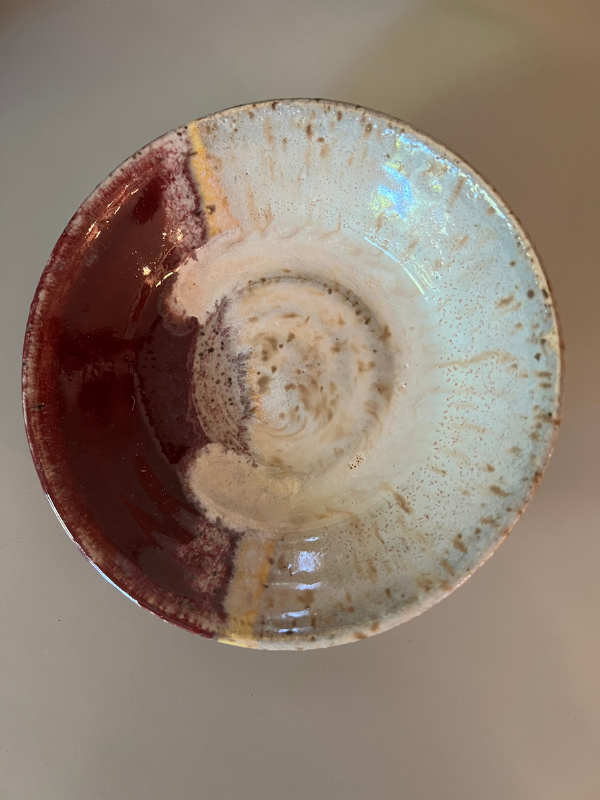
"Still Learning” by Saba Harouni Lurie.
Ceramic. 05/25/22.
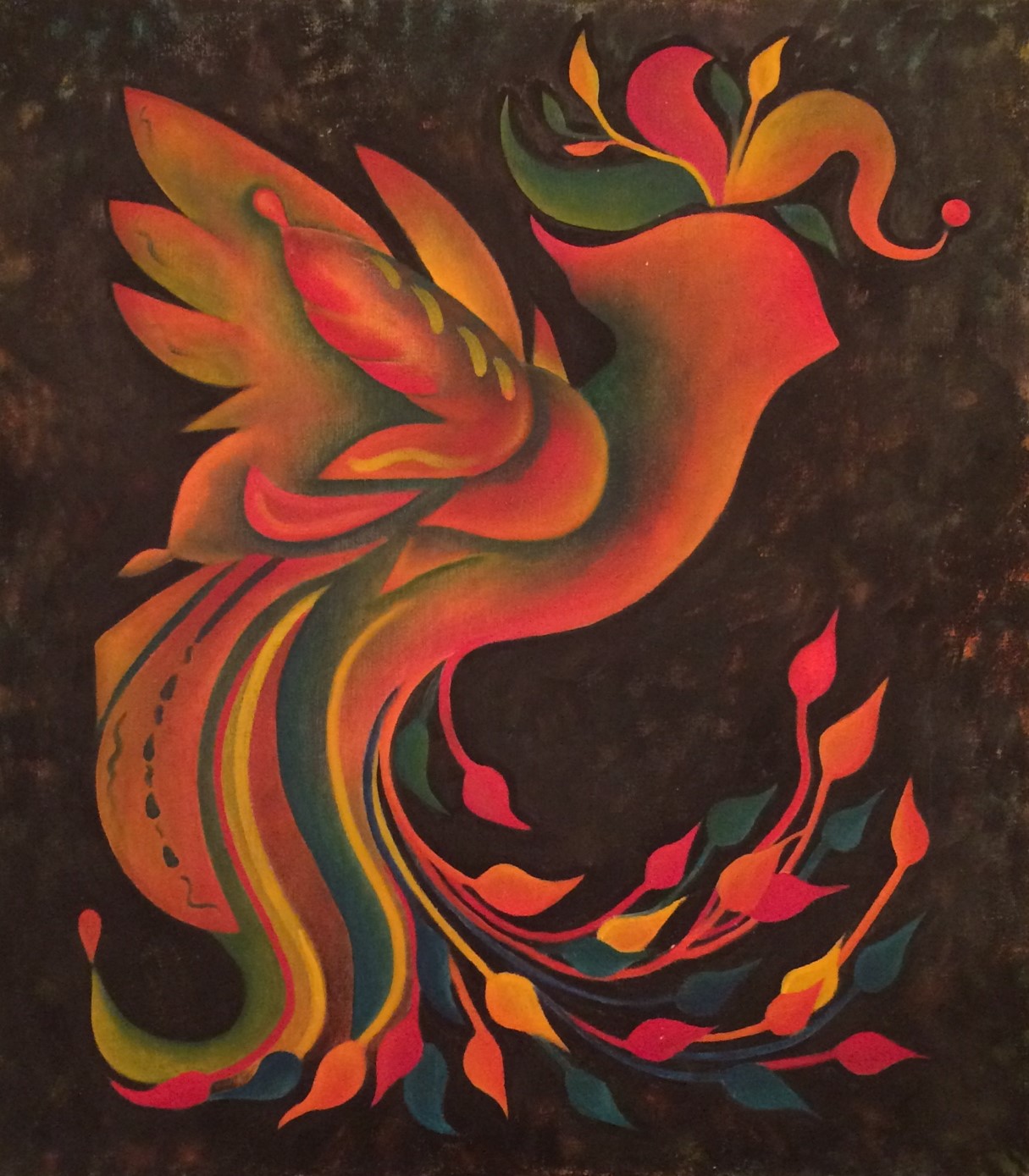
"Bird of Paradise” by Megan VanMeter.
Oil on canvas. 2/6/1989.
““Bird of Paradise” is the image I use to help others understand the numinous qualities associated with the Symbolic component of the Expressive Therapies Continuum. Though I created this painting more than 30 years ago, it continues to mesmerize me with its mysteries.”

"Untitled” by Makiko Harada (Young).
Photography.
This is a shot of my hand. For me, salt is edible art. I cherish and am blessed by its beauty.

"Nothing is more important” by Jie Shen.
Collage on cardboard.
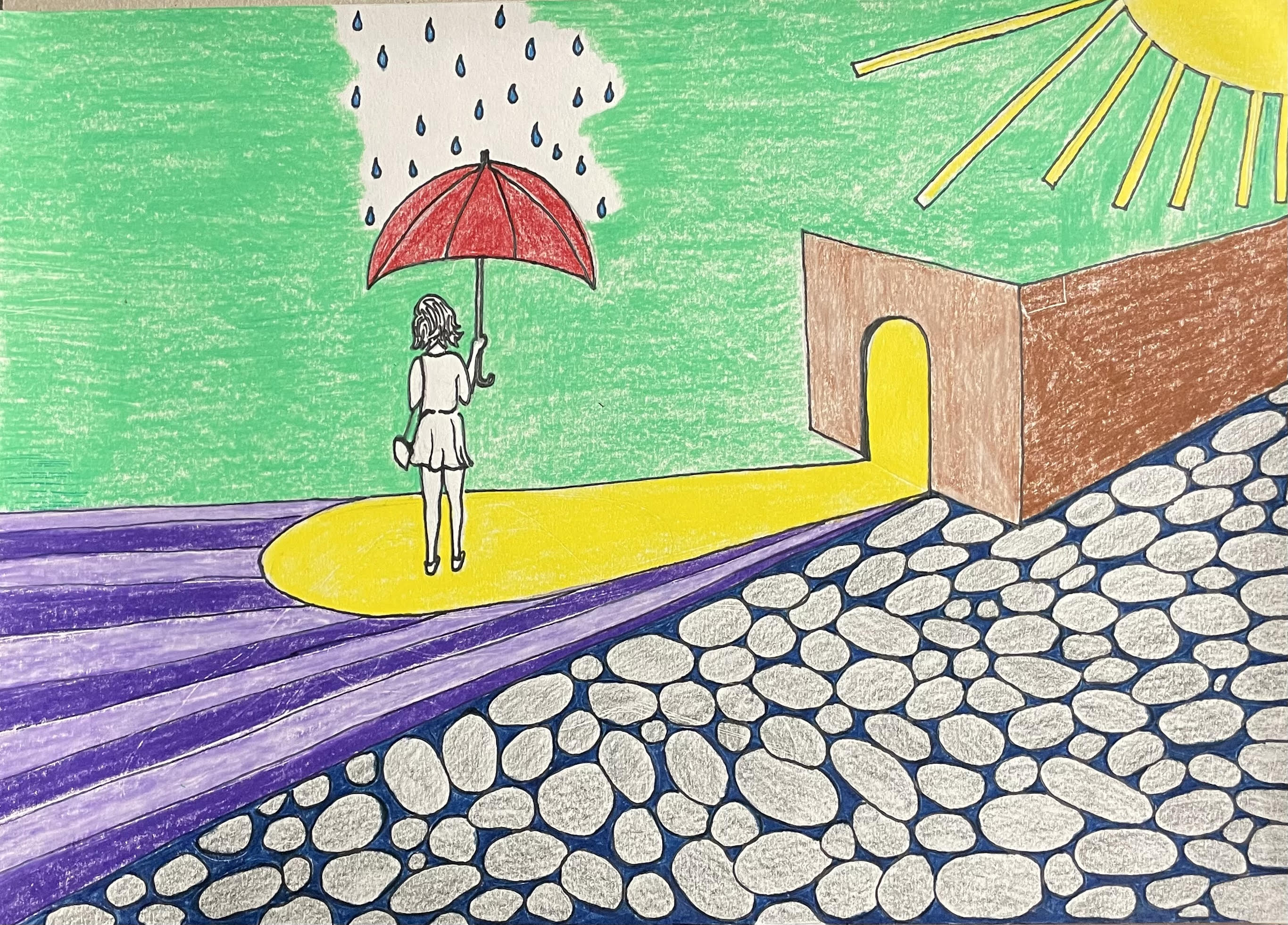
"Which Way?” by Nomita Advani.
Ink pen and colored pencils. 01/01/2022.
“My art process is a visual journaling of significant moments and experiences and my response to them. I have found that my paintings have facilitated my own expression as well as a connection with those who view them through the universal human condition expressed in my visual language.”

"Re-turning Pages” by Virginia Bobro.
Handmade book: paper, hand-printed fabric, water-soluble pens and pencils, ink, thread. 3/14/2022.
“I made this book as part of a final intermodal project for the “Principles and Practices of Expressive Arts Therapy” class at Lesley University. After reflecting on aspects of my identity as an artist and emerging arts therapist, I explored the interplay between trauma, mirroring, creativity, and integration.”

"Untitled” by Emily Allbery.
Earthenware, burlap, glaze – hand built ceramic platter. 2020.
“I typically view my own artwork as a way to share my love with other people. Which typically means the majority of my art lives in the homes of people I love. I enjoy making utilitarian pieces that can live in every day; making beauty out of the mundane.”

"Raison d’être.” by Leonard Gerald Lambert.
Pointillism, tempéra paint on paper. c. 1976
“This mosaic-like piece was created to articulate my observations and responses to life’s struggles and complexities.”

"Self Portrait: The Color of Pride” by Keren Arroyo-Mora.
Pencil and Watercolors. 3/12/2020.

“A Shell’s Journey” by Girija Kaimal.
Atlantic clam shells and paint pens. 8/8/21.
“Being outdoors was one of the few free activities during the pandemic and as a result in 2020, my art took an even more intentional turn towards mixed media inspired by natural materials and nature metaphors. Instead of traditional canvases, I have increasing been using elements of nature as both themes and the base for my art. Natural materials represent to me the transient beauty and anonymity of everyday lives as well as the paradoxically universal uniqueness of all beings.”

“Happy Space” by Lauren Hall.
Chine collé linoprint. 12/10/2020.
“A representation of everything that gives me solace.”
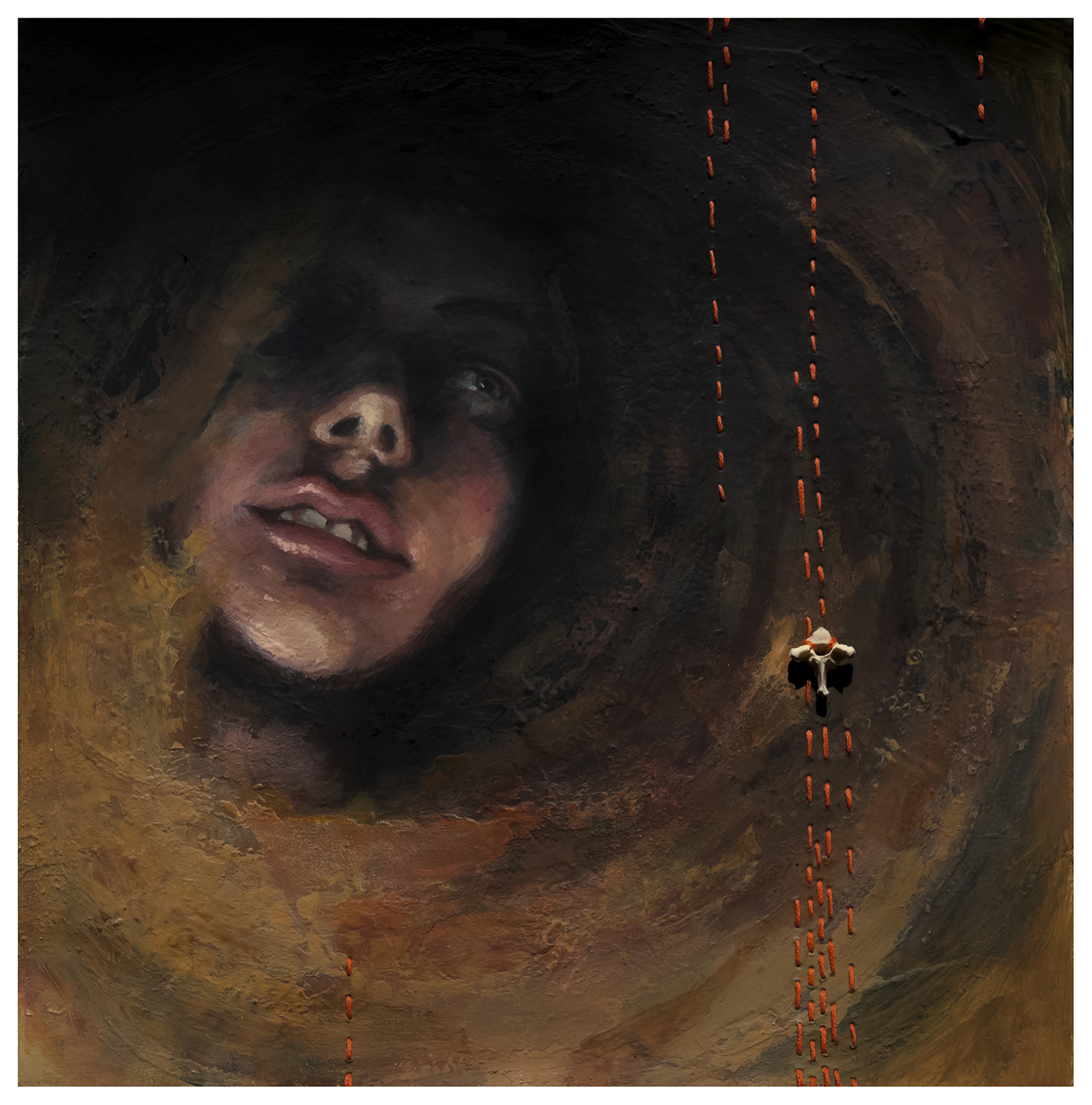
“Rich Forest of Breath & Burrow” by Beckett Weeks.
Acrylic paint, embroidery floss, animal vertebra. 2019.
“This work was done as part of Push/Pull gallery’s “Stanza: Fire” show, in which each artist was assigned a poem and instructed to create work inspired by the poem.”

“Birdseye in The Attic” by Moriah Mylod-Daggett.
Charcoal, graphite, watercolors, and Ink. October 10, 2021.
“Initially my paintings begin intuitively by cathartic mark-making. I believe this oracular method provides an unrestricted space that can flow freely; the paint knows where it wants to go before I do. Sometimes, a watery spray on the surface creating layers of acrylic paint: there beneath the dripping paint emerges abstract worlds in untamed color palette and shapes of ghostly figures, mountain peaks, valleys, skies that sometimes morph into eyes, trees, hearts, rivers, the endless galaxy & repeating forms where they are later emotionally refined and defined through pointillism and painted layering. I appreciate working on wood because of the innate life-force wood has within the grain, rings, texture and smell. I am drawn to engage with the painting on wood surface because it once was alive and here I give it new life, expanding its life force in the opportunity to birth something new into the world that essentially wasn’t there before.”
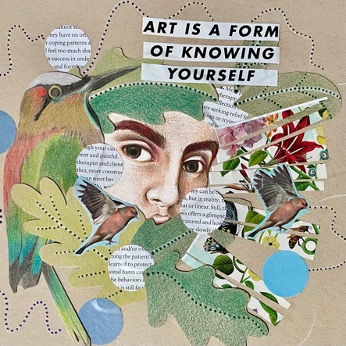
“A Glimpse into Freedom, Safety, and Resilience” by Sonia Castro.
Mixed media. September 21, 2021.
“In this piece, I explore the various layers of my cultural identity that have sustained and lifted me during my own process of change and healing.”

“Family Reunion” by Franchesca Lastra Vicente.
Acrylic on paper. 2012.
“’Family Reunion’” was specifically created during a time where I was starting to gain more interest in learning about my ancestors and cultural roots. Many of my family live in Puerto Rico so we often do not get an opportunity to spend time together. So with this piece I wanted to create a moment in time where we could all be together. I feel that nothing can describe my hispanic heritage more than when I am with my family. Moments where we can just gather together to create happy memories and laugh. I chose to collage some of the old black and white photographs given to me by my parents and transformed them into a collective painting with all of us gathering for a family reunion.”
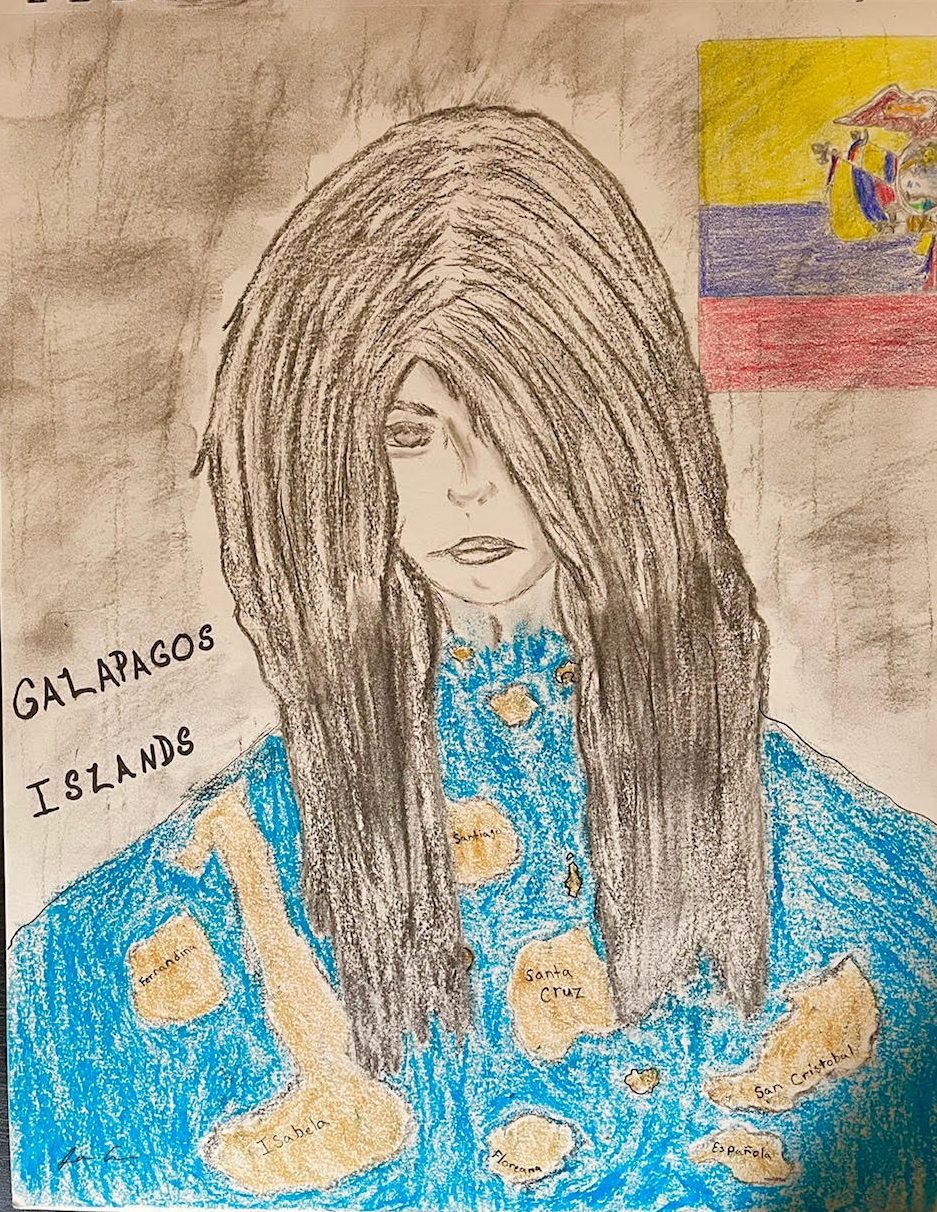
“Las Islas de los Encantos” (Enchanted islands) by Jessica Cabrera
Color pencil, ink pen, oil pastel and charcoal. August 30, 2021.
“I depicted the Galapagos Islands map because of the love I have for animals and nature. I am honored to be an Ecuadorian American. I will continue to appreciate my culture by creating more artwork based on my ethnicity.”

“Love Heals All” by Jennifer Schwartz
Mixed Media Paper Collage. March 18, 2015.
“I’m usually an expansive, expressive, and messy artist. However, when my late husband died suddenly in 2013, this collage helped me cope with the loss.. The structured design, intricate papercut letters, beautiful textured papers, and ancient wisdom of the message sustained me through this dark time of my life. Love heals, indeed. And art does too!”
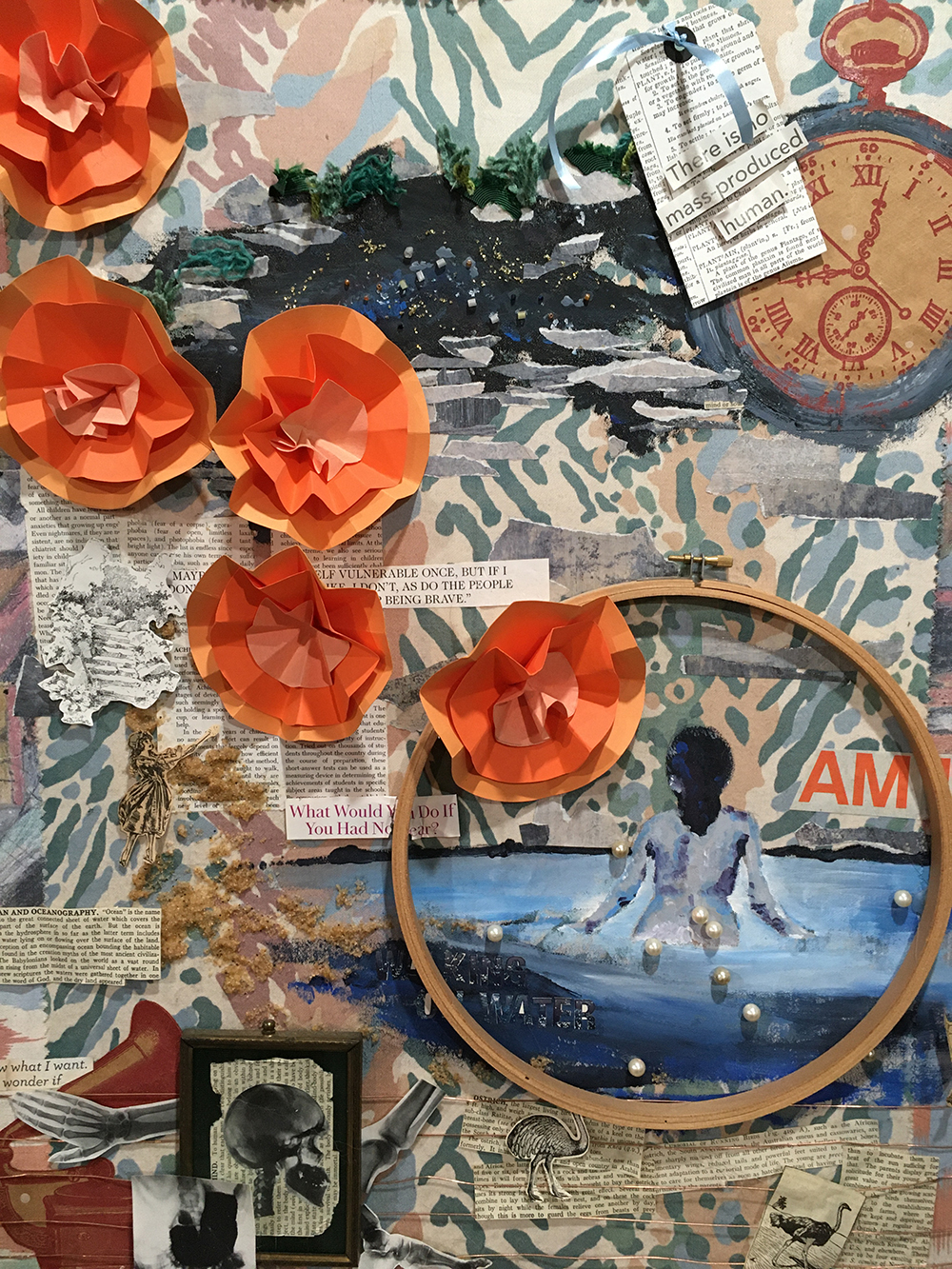
“Vulnerability” by Janna VanderBand
Acrylic paint, fabric, beads, and collage materials. April 20, 2016.
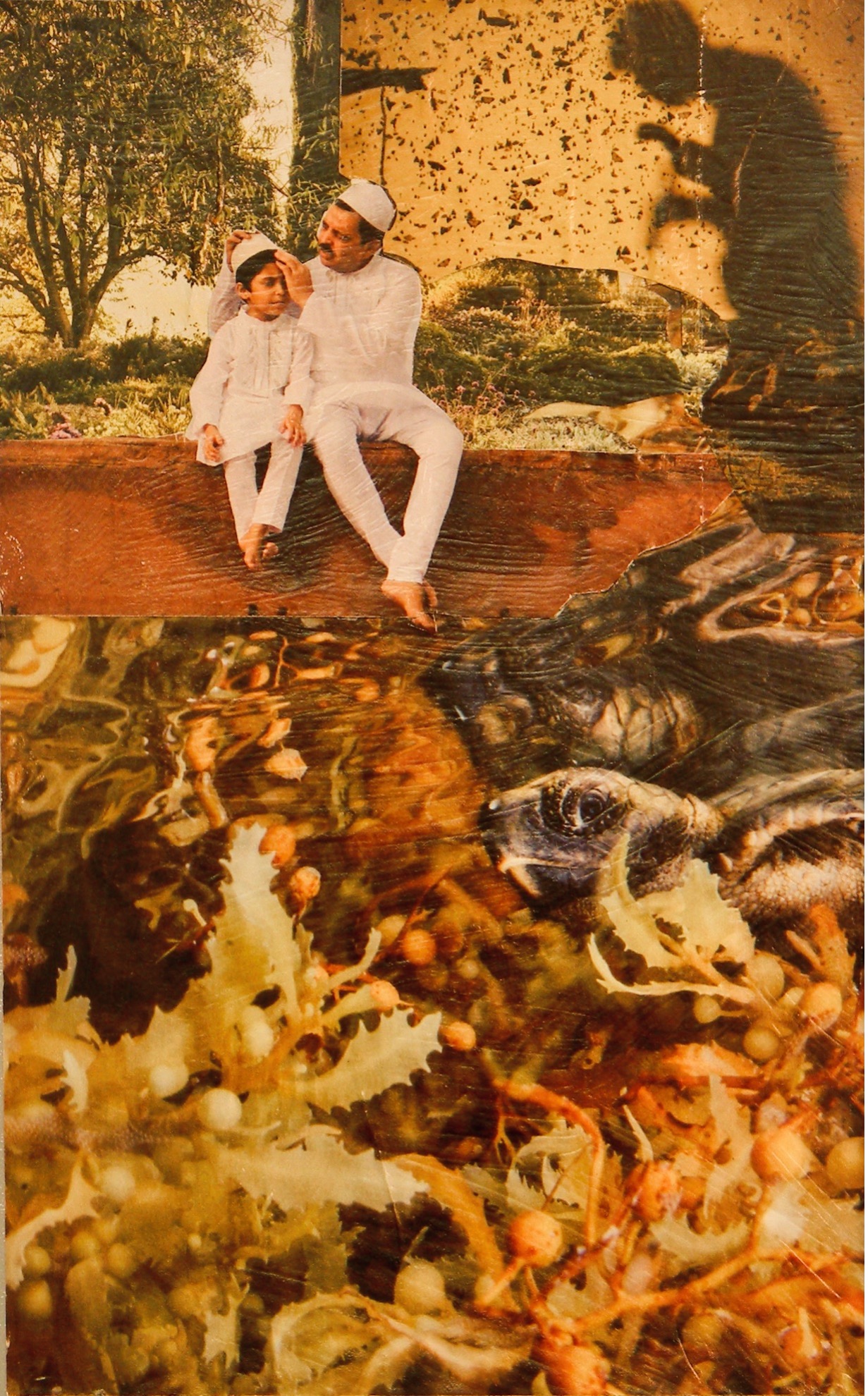
"I am the One Who is Comforted” by Jonathan Haag
Soul Collage. October 1, 2021.
“I made this piece with students as we explored the process of Soul Collage as part of the course, Introduction to Art Therapy in the Fall of 2020. The collage reflects my experience of receiving comfort from God during this difficult time as well as my desire to be a source of comfort to others.”

“One With the Butterfly,” by Zulay Romero
Digital Collage. November 1, 2020.
“Last year, I decided to start exploring with digital collage. Collage, in general, has been home base for me for the past few years. When the pandemic hit, I didn’t know who I was anymore as an artist. I gave up art for some time and instead immersed myself in TV shows and artists on social media to keep myself distracted from the chaos that was going on outside my door. Procreate videos kept popping up on my social media and it really piqued my interest. This piece was one of the very firsts that I created. Using a site called Unsplash (website that has all sorts of free images that one can download), I chose different images that captured my eye and my heart.
Butterflies hold so much meaning. If one were to search the meaning of butterflies, one might find that it symbolizes hope, creativity, our souls, change, endurance, etc. I find it to be so true. 2020 changed everyone’s lives, whether it be for good or bad. For me, it was a year of finding my voice, finding what matters to me, and advocating for my needs (spiritually, emotionally, mentally, and physically). While I feel that year after year, that has been the common theme, finding my voice, I value that each year I have become stronger. While the world seems to pass us by, may we continue to find new beginnings, new strengths, and our voices.”

“Air,” by Paige Scheinberg
Digital art. June 9, 2020.
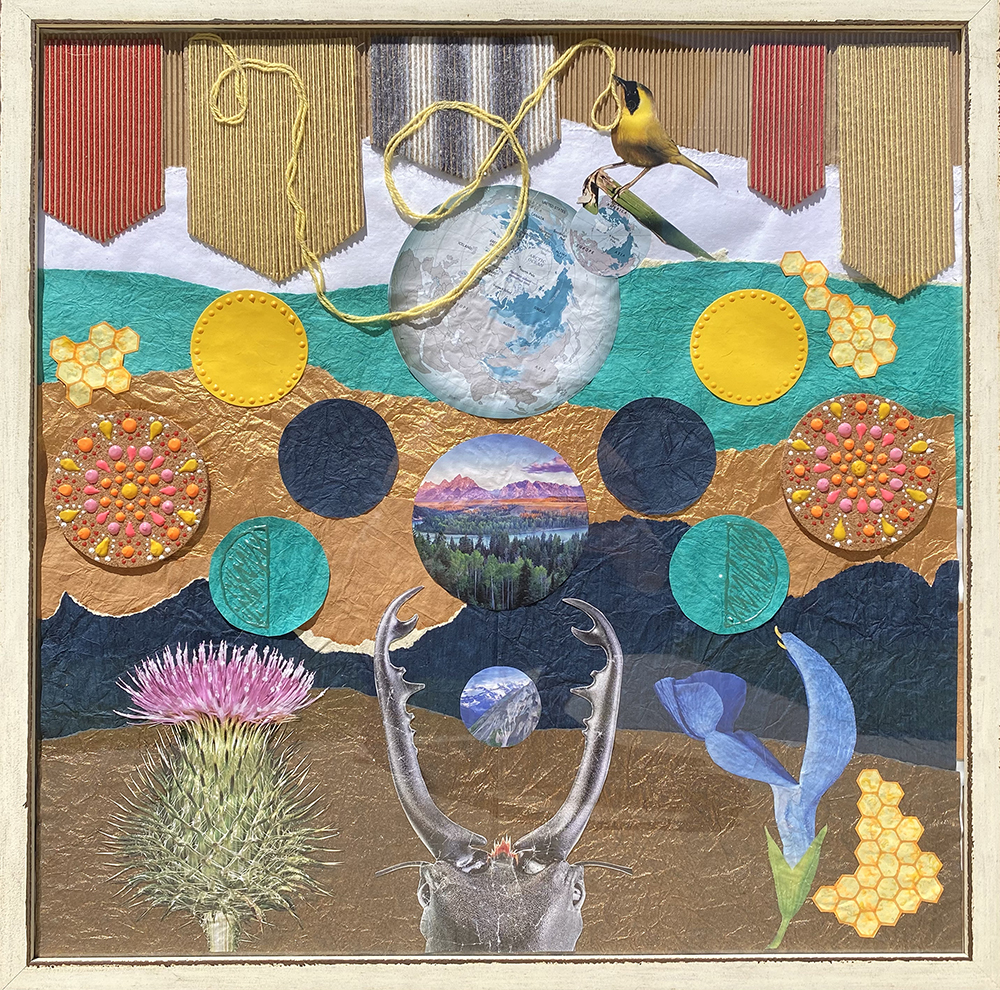
“Unbreakable Thread,” by Kristin Wunderlin
Mixed Media Collage. May 18, 2021.
“This ever-changing world can leave us feeling shaken and disconnected. And at the same time, parts of us are woven together by a thread built out of collective traumas and a desire to heal. Healing is not linear, much like this unbreakable thread, charting a unique path in each of us and emerging out of moments of hope.”

“Untitled” by Sharelle Langaigne
Clay and acrylic paint. December 2020.
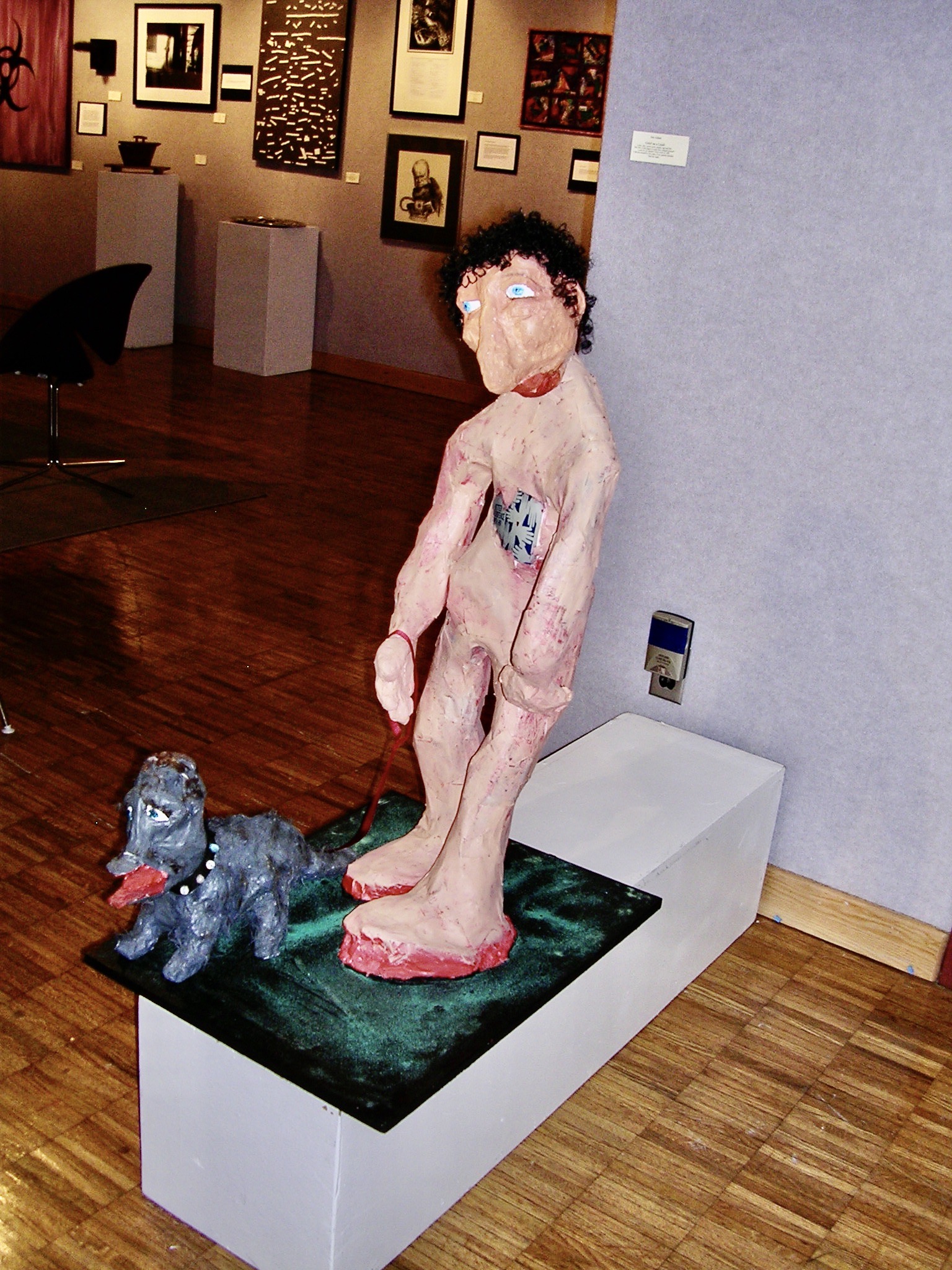
“A Man and his Dog Named Grief” by Dan Anthon
Wire armature, torn note cards, wheat paste, hair, rhinestones and paint. 2007.
“I’m a painter, sculpture is not my medium, but Don Seiden inspired me to try. I made this figure to demonstrate the process to a young man who wanted to make a figure his own size. My sculpture was part of an exhibit for artists affected by HIV/AIDS, entitled “…And Our Art Lives On: A Legacy of Survival…”. His feet rest in a pool of blood and his skin was created from wheat paste and 3”x5” torn cards (paper-mache) which contained the notes from my 1988 work on an AIDS designated hospital unit. Years later I unearthed these notes and had forgotten that nearly every one of my patients had died. The rather grotesque canine companion has a lovely rhinestone collar, and the man steadies Grief with a leash.”
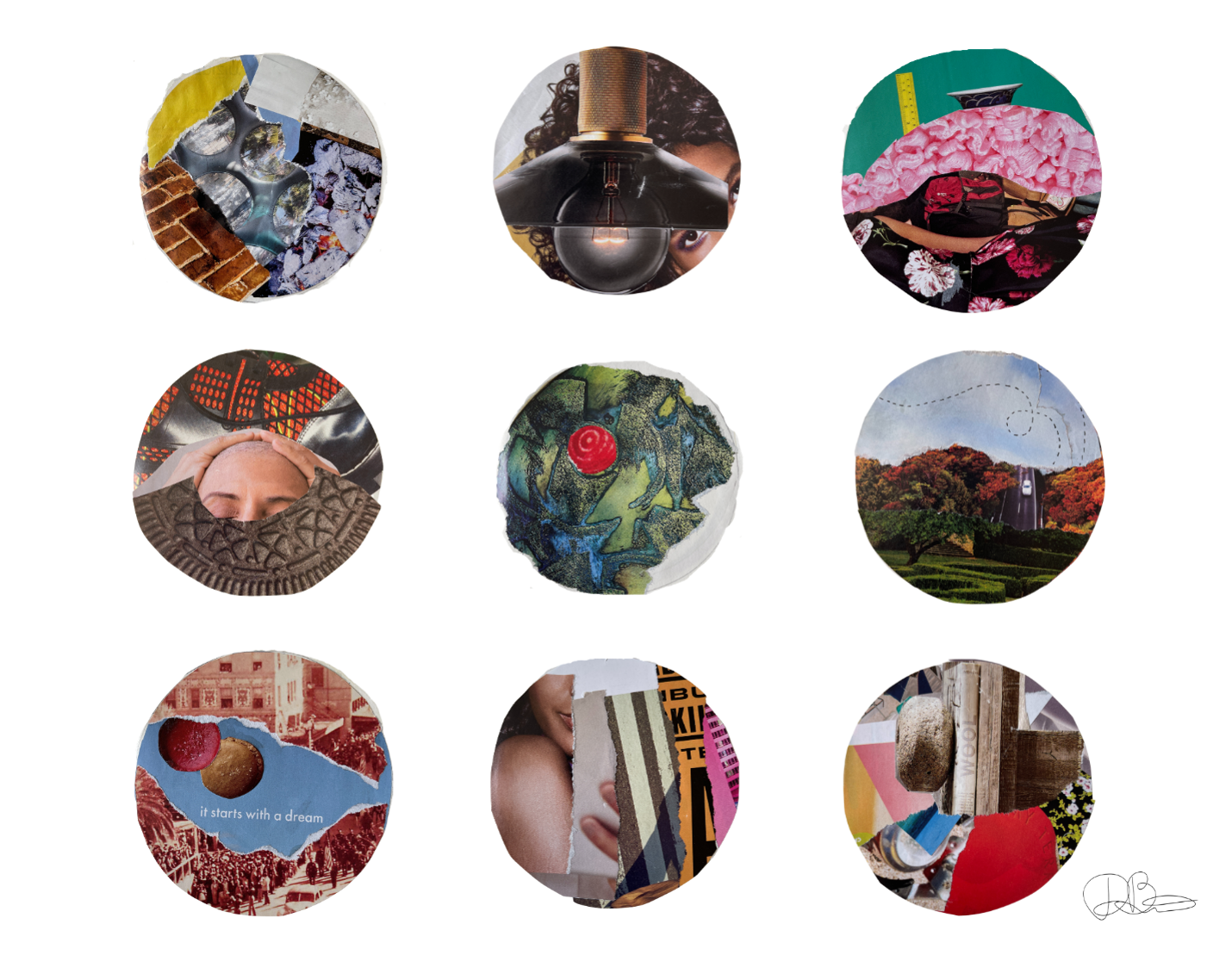
“Daily Circles from 2020” by Deanna Barton
Torn magazine pages on paper. July – Dec 2020
“Creating a daily circle (aka mandala) during COVID became a way to quickly process thoughts and feelings related to isolation, community, injustice, pain, change, identity, grief, and healing. Each circle was created intuitively without much planning and the process was usually accompanied by music. Individually, the circles are a record of a moment in time. Collectively, the circles illuminate my humanness. The practice of creating daily circles became a process I shared with my clients, many of who adopted this practice and adapted it to their needs and medium of choice.”

“Resilient Rocky” by Catherine Harris
Mixed Media on Paper.
“I’ve been thinking a lot about the idea of resilience lately, and with that, the story of the owl found in the Rockefeller Christmas tree this past holiday season keeps coming to mind. A Saw-whet owl, the tiniest of owls in the northeast, was trapped in the tree as it made its 170 mile journey to New York’s Rockefeller Center.
The owl had not eaten or drunk for days, but after rest and care at the Ravensbeard Wildlife Center, she was able to take flight again and return to the wild. The vets who treated her called her one ‘tough little bird.’
This little but tough bird seems an appropriate symbol for the idea of resilience to me. It’s not so much that we’re able to prevent or avoid the struggles and challenges that inevitably arise. It’s that we’re able to care for ourselves and restore our energies when they do.”

“Hekla“ by Aimee Jette
Acrylic and collage. August 2017.

“North Mississippi–Study“ by Kristina Burrow Woodruff
Oil paint and palette knife on wooden panel.

“Be Still” by Seraiah Simmons
Acrylic paint and collage. May 2020.
“This mixed media artwork was created through an El Duende (layering) process. It captures personal, professional, and academic experiences that I endured within my 2nd year of art therapy graduate studies and clinical internships. Day by day, details were added. Now the canvas holds abstract pieces of my heart, representing integration and wholeness.”
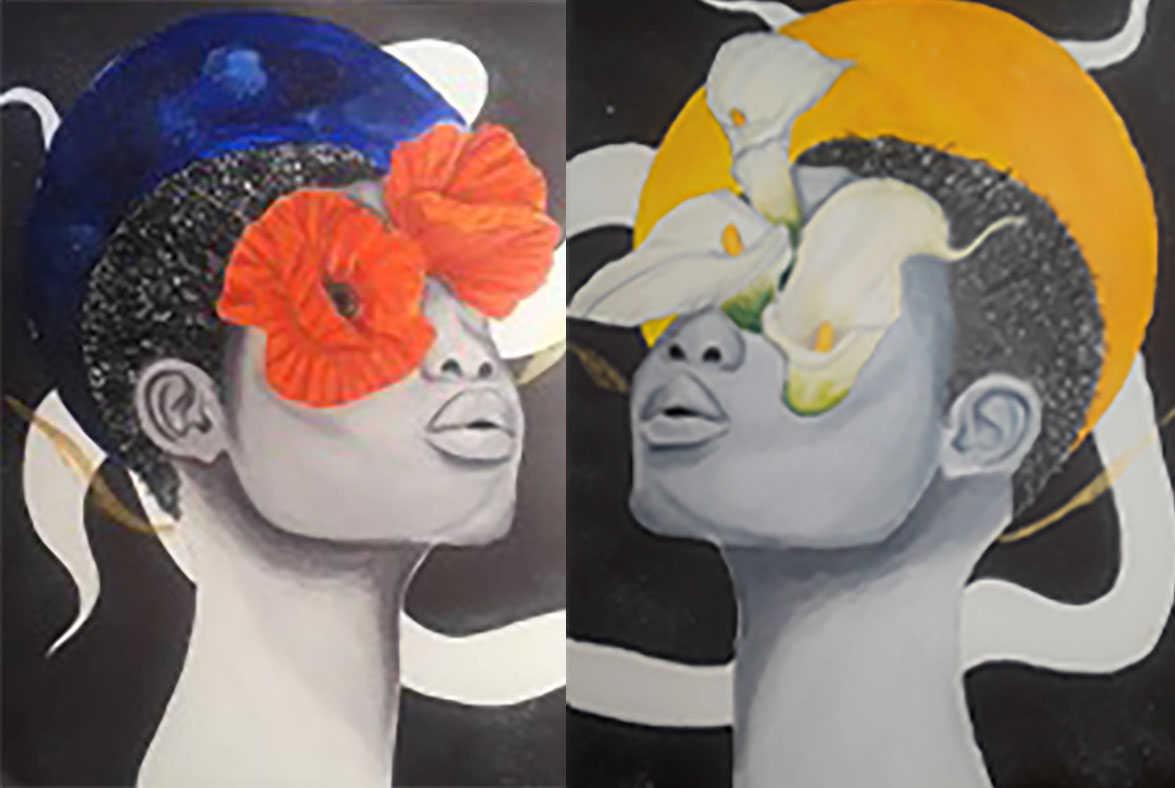
“A Communal Encounter” by Mariah R. Gray
Acrylic paint, markers, and colored pencils. February 2021.
“A communal encounter, meaning an experience shared within the same space as others, was my inspiration for this art piece. I wanted my artwork to exemplify the terminology, “I see you” and represent every aspect of its meaning. Although not every student will have the exact same background, being in the same space together allows for a bond and connection to form that is unlike any other. I am truly grateful for the bonds I have established with those in my program and I look forward to furthering this experience.”

“Step by Step” by Ashley Abigail Gruezo Resurreccion
Acrylic Paint on Vinyl Record. December 2020.
“I want the intersectionality of my soul to be unconditionally regarded, and for our unequal walls to be dismantled, so that we may live within a place of healing rather than dissonance.”

“Never Good Enough” by Elisha-Rio P. Apilado
Mixed Media (ink, acrylic) on wooden canvas. 2019.
“I am a Filipino-American and the only one among my siblings born in the States. It was challenging to comprehend which culture to embrace fully. The more I tried to be American, the more I was ridiculed. But the more I tried to be Filipino, the more I was yelled at for not being a “true Filipino” because I didn’t speak Tagalog fluently. This series features reflections on my mental well-being influenced by years of bullying, discrimination, and my self-esteem getting knocked down. I’ve seen first hand how being vulnerable about our mental health issues, especially within minority groups, has helped others better embrace themselves and recognize they’re not alone – so I hope this resonates with you. “
Never Good Enough” is dedicated to all those who have been affected by discrimination and unfairness to the point where it has caused a shift in their mental health. After reading through E.J.R. David’s book, Brown Skin, White Minds, I was appalled by how mental health is unimportant in Filipino communities. According to the research on the mental and behavioral health implications on Filipino-Americans, they have the highest rates in suicidal ideation and have a higher rate for self-esteem issues, substance abuse, incarceration, and schizophrenia (David, 2013, p. 145). This layered mixed media painting depicts how much my identity has been shattered by racial slurs and never feeling good enough to be neither American nor Filipino.”

Untitled by Deborah Good
Agate stone and gold. September 2020.
“My art form is lost wax casting in precious metals. I started these earrings a few years ago, but I never finished them until this past September. They are gray, striped agate stones set in 14 carat gold. My style is to braid wax wire and use that as a base for the stone settings. It’s tedious work, but I love the process of casting the wax model into metal. There’s something fascinating to me about liquid metal.”

“Offering” by Melissa Raman Molitor
Mixed Media with Papyrus, Fabric and Found Objects. 2016.
“As an artist, educator, art therapist and activist my work is multidisciplinary in nature. My personal art work is an expression of my lived experiences and the narratives associated with my identity, generational history, and intersectional cultures. My social art practice is the creation of ‘third spaces’ in my community — spaces that exist in between and outside of the ‘norm’ and encourage connection, creativity, learning, growth, courage, resilience, resistance, and empowerment. I believe that third spaces are the areas where we can collectively harness the power of the arts to learn from, respond to, and address the historical and current socio-cultural-political injustice experienced by people who are identified as ‘marginalized’ in our country but are the global majority.
I bring not only an educational and aesthetic approach to my work, but also a therapeutic lens to designing and implementing art-based projects that seek to decolonize art in our communities, are culturally relevant, inclusive of diverse backgrounds and abilities, equitable in access, sensitive to emotional and psychological concerns, and trauma-informed.”

“The Embrace” by Asli Arslanbek
Mixed media on paper. 2020.
“This is an artwork I made as a closure to an auto-hermeneutic inquiry. It is about witnessing, familiarizing, understanding, making sense of, and embracing my younger self. The weights that we carry, that are attached to us, are our assumptions about each other. My younger self wonders who I will be as an adult, while my current-self questions who I was as an adolescent. And they meet and embrace each other through an inquiry and art-making that accompanies it.”
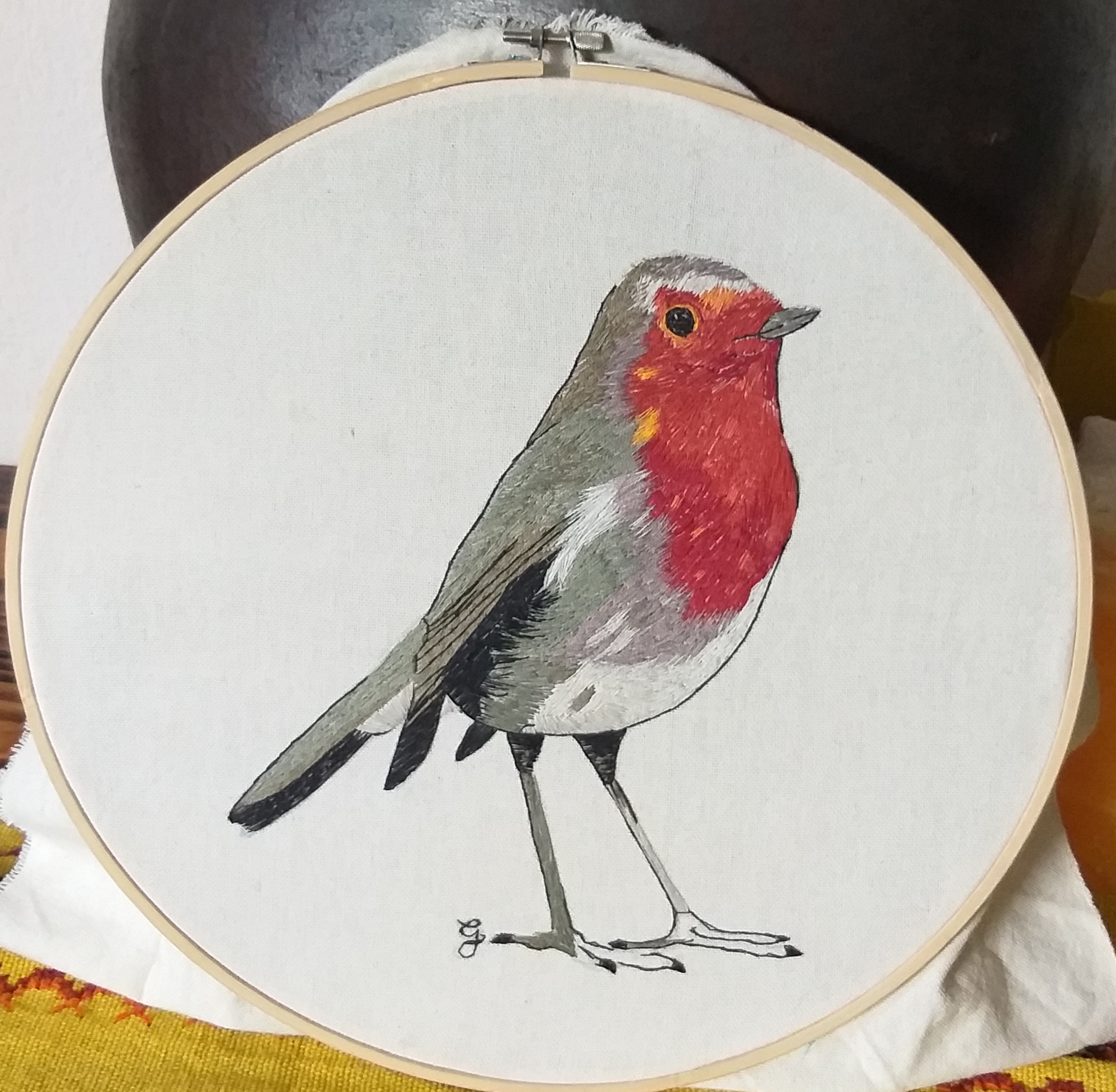
“Construcción” by Gabriela Osorio
Yarn. May 2020.
“This was my last artwork during the first two months of the pandemic. This bird helped me to feel free in such difficult times. I always wanted to feel that I was almost painting, but with yarn.”
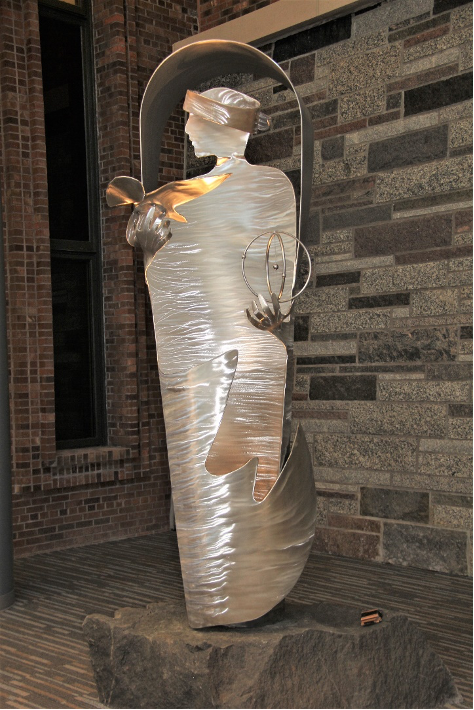
“Wisdom Heralding Peace,” by Sara Balbin
Stainless steel. 2012.
“The commemorative plaque that accompanies the sculpture contains these descriptive words: This sculpture calls us to utilize the wisdom of science to promote peace and to see God through learning. The sculpture’s conical shape depicts the Communion cup. The veil represents the Benedictine sisters and echoes the arches found throughout the main campus’ architecture. The dove mirrors the Holy Spirit and peace. The atom signifies learning through science. The light portrays eternal wisdom. The waves symbolize baptism and the waters of Lake Superior. The bluestone rock from the grounds of the main campus represents the House of Stone and the College. This sculpture was commissioned in celebration of the College’s Centennial. 1912-2012. For the Love of Learning.”

“Create Communicate Connect” by Virtual Art Camp 2020 campers
Primed Plywood and acrylic paint. August 2020.
“Each camper and facilitator took an individual letter to paint and at the end we brought them all together to spell the theme of camp, ‘Create, Communicate, Connect.’ They were installed at The Kelley Farm Preserve in Bernard, Maine as part of an outdoor art walk. The art walk served as the end camp show and to invite the public to witness the art made in the individual homes of the campers. I personally painted one of the N’s in CONNECT and used the Progress Pride Flag as a backdrop because its message embodies what camp was all about this year.“ – Dawn Nuding
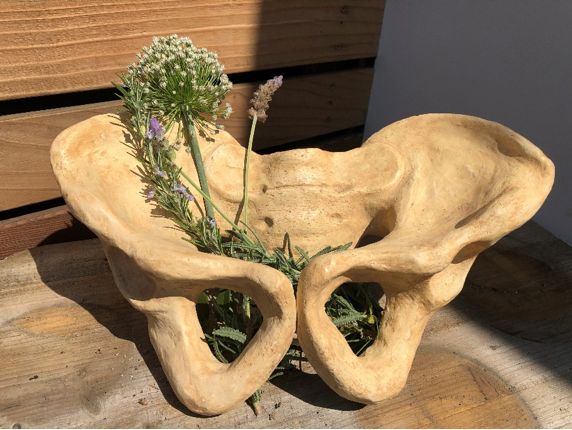
“Bony Basin” by Caitlin Brosious
Clay, acrylic paint.
“Cradled and contained, yet open and laid bare to the elements. Strong, curious, wounded, and fearful. I am alive. I am quietly screaming, I am loudly screaming. Pleasure, anguish. I am sure, yet wholly unaware.”

“We are Born with Targets on our Backs” by Edith Juanah
Acrylic Paint. June, 12, 2020.
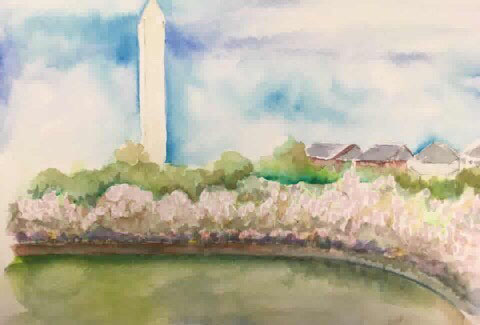
“Tidal Basin” by Rachel Albert
Watercolor. March 2019.
The Conference Committee recognizes Rachel Albert, ATR, whose artwork was selected for the 2020 Annual Conference Logo for the Washington, DC in-person conference.

“Silent Protest” by Alby Gyimah-Boadi
Photography, Vinyl, Textiles. June 19, 2020.
“The evolution of how I processed the death of George Floyd and the rising racial tensions in America turned into my idea of a silent protest. Getting my voice heard the best way I know how: which is creating.”

“Bubbe-Meises” by Zachary Van Den Berg
Oil on Canvas. March 2020.
“This painting, Bubbe-Meises (Yiddish for grandmother’s tales), is a selected piece from my current series, Becoming. These works are responses to the journey of cultivating my professional identity as an art therapist. For the last seven months, I have been working closely with Judith A. Rubin, and the Expressive Media team, to launch her comprehensive Film Library, consisting of archival footage, interviews, documentaries, clinical sessions, and conference presentations. Through this initiative, we have formed a meaningful collaborative partnership. Bubbe-Meises is an homage to her wisdom and an expression of gratitude for her presence in my life.”
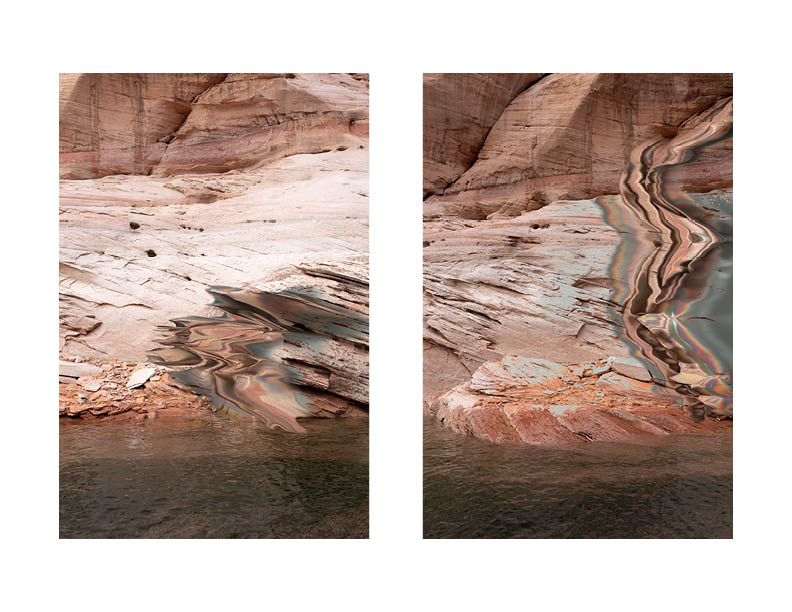
“Temporary Deformations" by Farah Salem
Photography, Fabric, Digital Renderings. April 2020.
“Since the pandemic started, I have been working in my studio on a series titled Temporary Deformations. I started working with old photographs and found materials around the house to create a series of digital renderings which brings forth fiber glitches embedded within desert rock landscapes. Introducing these glitches implies a moving body that emerges from the cracks of a rigid boundary. It brings agency and movement to the rocks which emulate an illusion of stillness, yet truly they are in constant movement. The movement of formations is dictated within the context of the photograph in relation to the friction generated by moving fiber images, challenging restriction. When viewing the work the definition of bodily motions with distinct expressions is projected on the rocks. Fiber layers enable a seamless disruption of the compressions. The work indicates that the illusion of a state of stability is about to fall before the viewers eyes. The desert landscape elicits unknowns and insecurities; thus we’d rather hallucinate a familiar reality governed by stagnant pre-conditionings veiled in the name of traditions which we have yet to shed. To me, this was a response to many things I was witnessing in our world, but mostly, our confrontation with uncertainty as a result of COVID-19, and how we were seeing old structures crumble and reveal their lack of sustainable foundation.”

COVID-19 response artwork by Ori Cruz
Colored pencil, markers, stickers and metallic gold marker on construction paper. May 2020.

(Left) “Amygdala #12" and (Right) “Amygdala #26 (Big Fish Syndrome)" by Jonathan Soard
Spray paint, stencils, china markers, on stretched canvas. February 2020.
“I have included two drawings from our time of Corona. I had started art-based research this semester centered around the influence of the amygdala on my actions and reactions. In essence, this series became response art in the context of a global pandemic. In retrospect, I can see the exuberance of the semester transforming into something else. I am remaining engaged in active imagination, carrying on a dialogue with this series. Still, it’s safe to say that the latter feels like the passing of a juggernaut, sweeping up all in its path.”
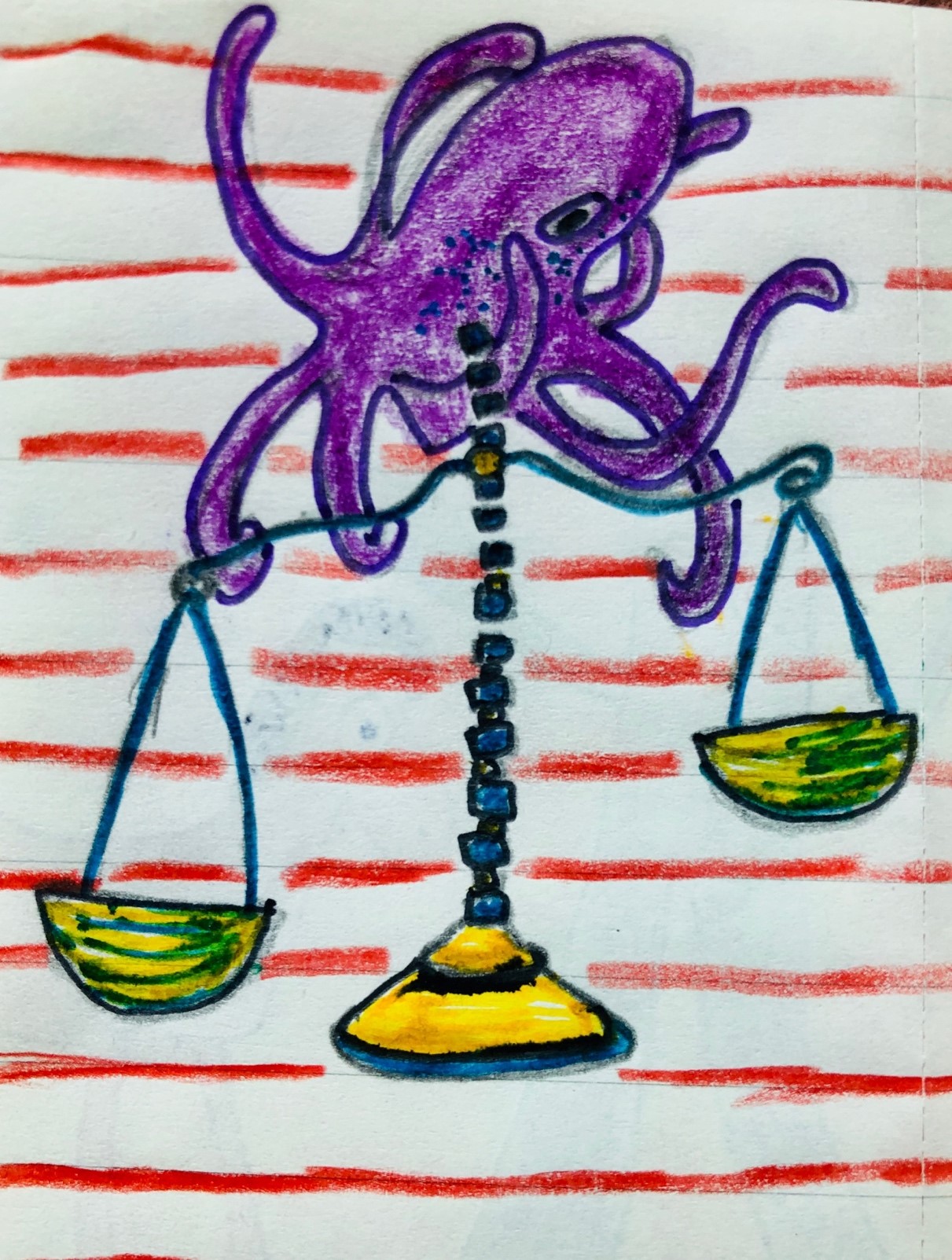
“Octopus Balance” by Alicia Ballestas
Pen and Color Pencils. 2020.
“The Octopus is known to symbolize complexity and deep emotions. Here the octopus is attempting to balance the scale without knowing the depth or complexity of what it has.”

“What’s The Use?” by Shelli McCaffrey
Mixed media. 2018.
“I [unknowingly] started a series of similar imagery at the beginning of my art therapy graduate studies, with this painting being the final one. The series became a reflection of “blooming” + growth, with an emphasis on femininity and vulnerability.”
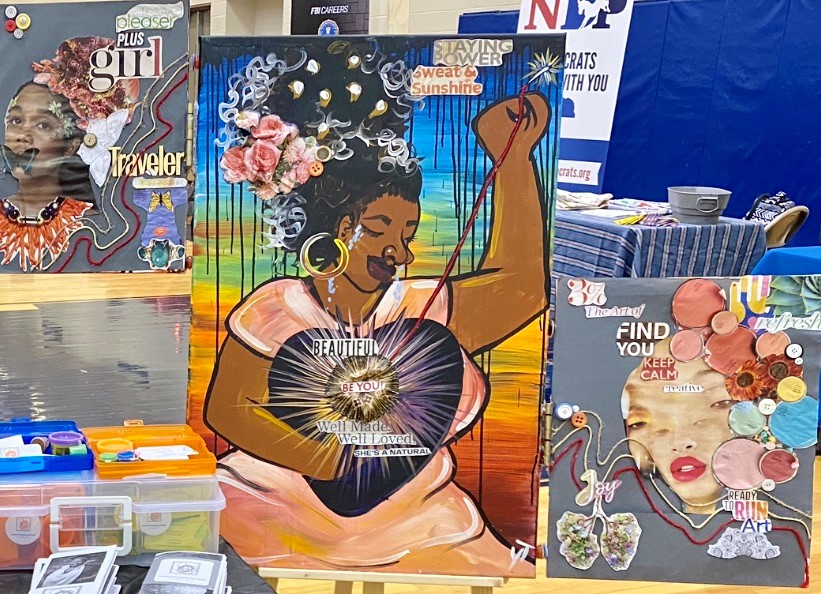
“Untitled” by Yasmin Tucker
Acrylic, magazine, yarn, paper and buttons on acrylic canvas. 2019.
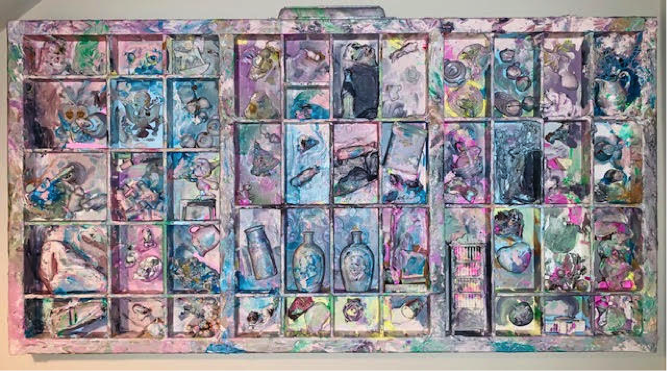
“Quarante Août” by Christine B. Haught
Mixed media/assemblage. 2019.
“As an artist, I spin together my ability to “look at the flowers” with my passion for alchemy. Through my creations, I share my inner zest for beauty and transformation with others. I have studied geomancy, feng shui, and metaphysical interpretation, and I believe deeply in the divine power of feeling my way through the world.”
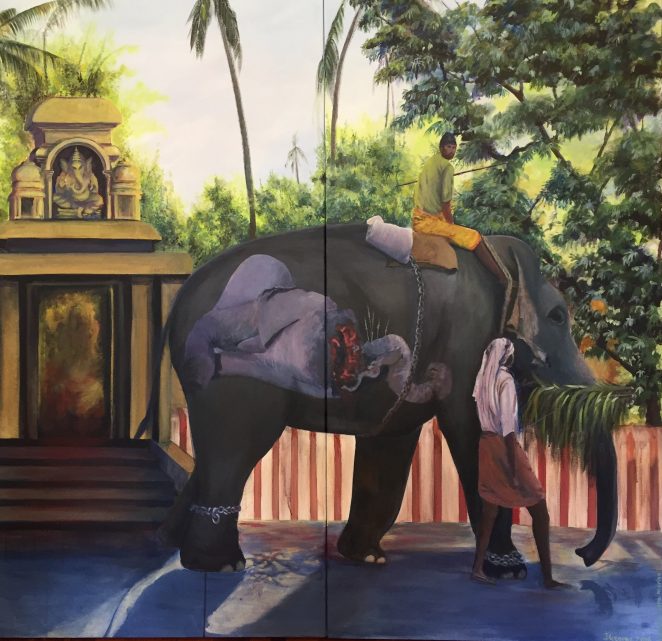
“And Ganesha looks on…” by Jayashree George
Acrylic on Canvas.
“In India, elephants are often painted and used for ceremonial purposes, often in abusive conditions. In this painting, I offer that if elephants were to paint on themselves, they might offer protest art, such as “don’t kill us.” This elephant has that message as Ganesha, the elephant headed god, looks on.”
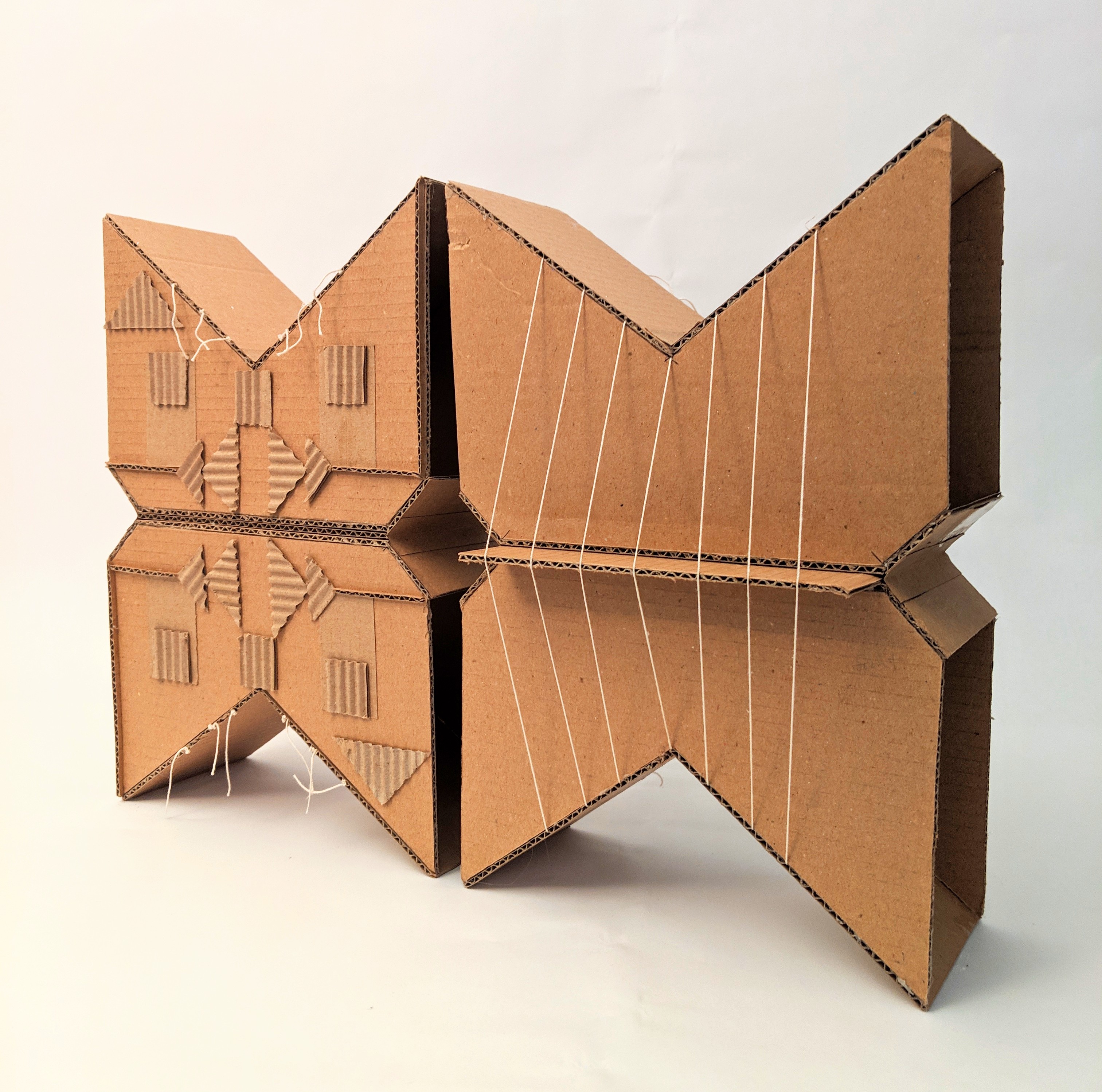
“A Weaver’s Modern Tale” by McKeon K. Dempsey
Mixed media. 2018.
“My personal relationship to art as a personal transformative process ties into my identity as a Diné (Navajo) woman with the ebb and flow reverberating from past generations of rug weavers, sand painters, and potters. My art not only increases the magnitude of historical agency, but also in the transformative power to delineate that of intergenerational trauma within my family. Art engrossed a sense of perseverance through hardship as an American Indian living in society today, as my art is a tribute to the resilient and unacclaimed agitations of assimilation. I can allude to the method of discovering the spectrum of human experiences through my ancestors and creating something of equivalence to their strength and guidance as leaders. My art reveals transpersonal themes through the basic archetypal principles emphasizing the importance of growth. The importance of defining, and redefining oneself spiritually as human experiences occur, my art ties into my identity within my community, in society, as I continuously seek the personal relationship with the Divine presence into reeducation to live a more holistic life.”

“Cheeze an’ bread” by Claire Kalala
Oil on Canvas. 2015.
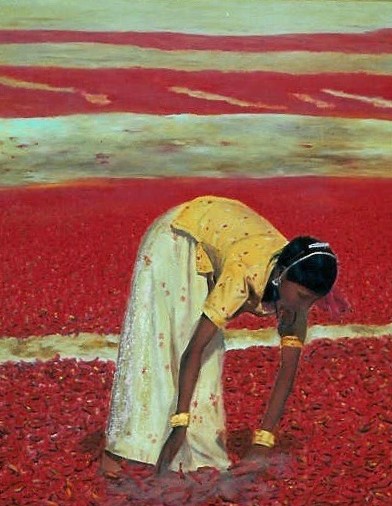
“Woman at work” by Laurence Vandenborre
Oil painting. 2012.
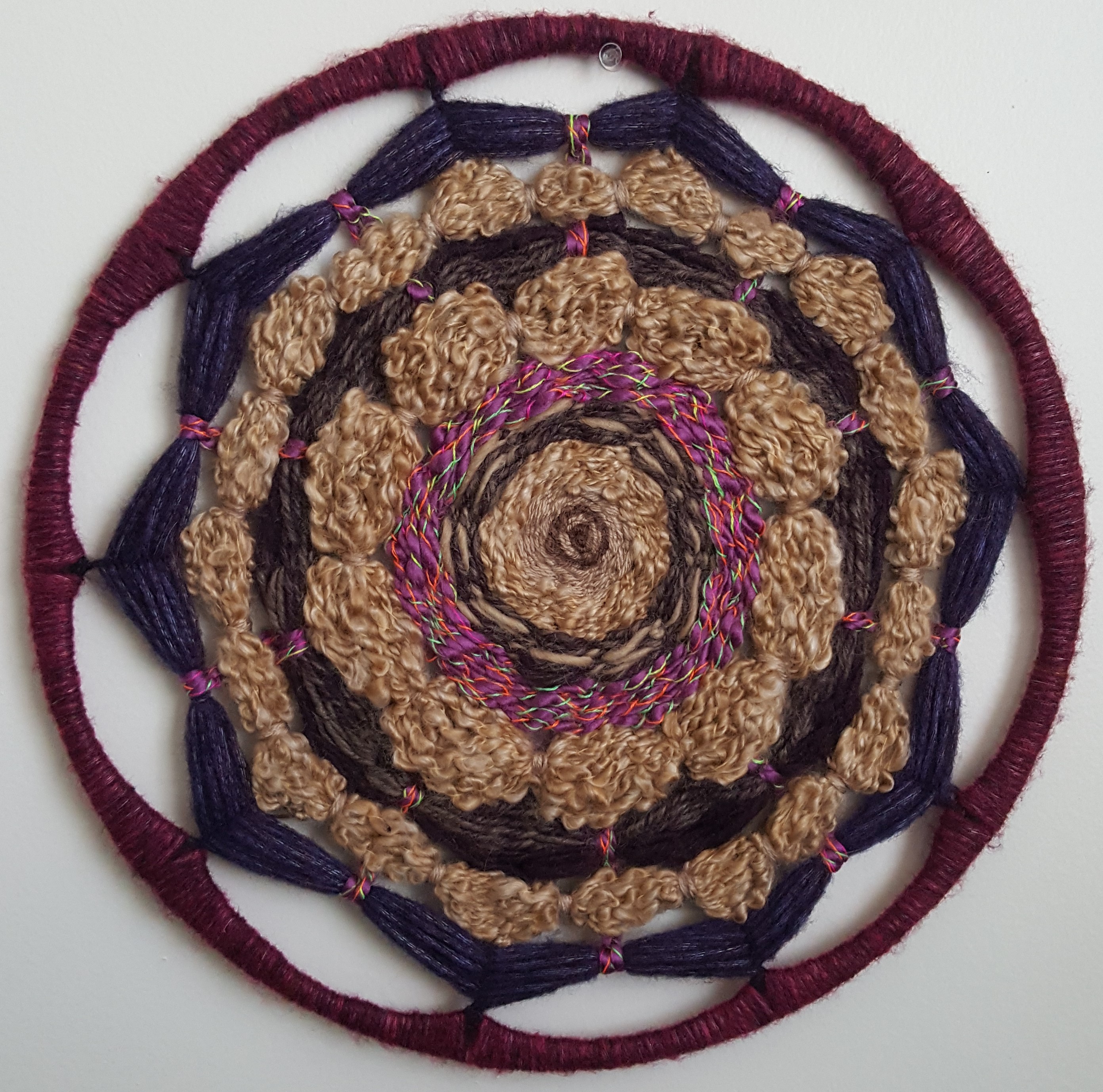
“Mandala Flower” by Susan Ridley
Fiber Arts Weave, Diameter 14.5.” July 2019.
“A Mandala is a Sanskrit word that loosely translates to mean “circle” or “center.” Throughout history, circles have represented the divine, infinite, or a path between inner and outer worlds. In Hindu and Buddhist traditions, Mandalas are an object of meditation to aid in one’s spiritual development. For the Chinese, a Mandala represented the Tao (Divine, Universe, God) in a Ying and Yang symbol that coexists in a Cosmic Dance continuously transforming each other. In Christianity, they can be seen in rose windows, rosary, and halos. The Celtic spirals and knot work represents a journey or movement in and out of the world, and for Native Americans they are seen in the medicine wheel, dream catchers, and shields. In Jungian psychology, a Mandala is symbolic of the inner process by which individuals grow toward fulfilling their potential for wholeness or individuation. The Mandala Flower fiber art represents the archetype of the self and a journey to create balance of psychological and spiritual health. It was constructed using a macrame ring and assorted threads. The fiber art evolved organically, starting at the center of the Mandala working outwards. Threads and patterns were chosen to compliment or contrast, to balance or create texture. Often incomplete Mandalas live on the wall until inspiration dictates the next movement, and they are completed when they feel whole.”
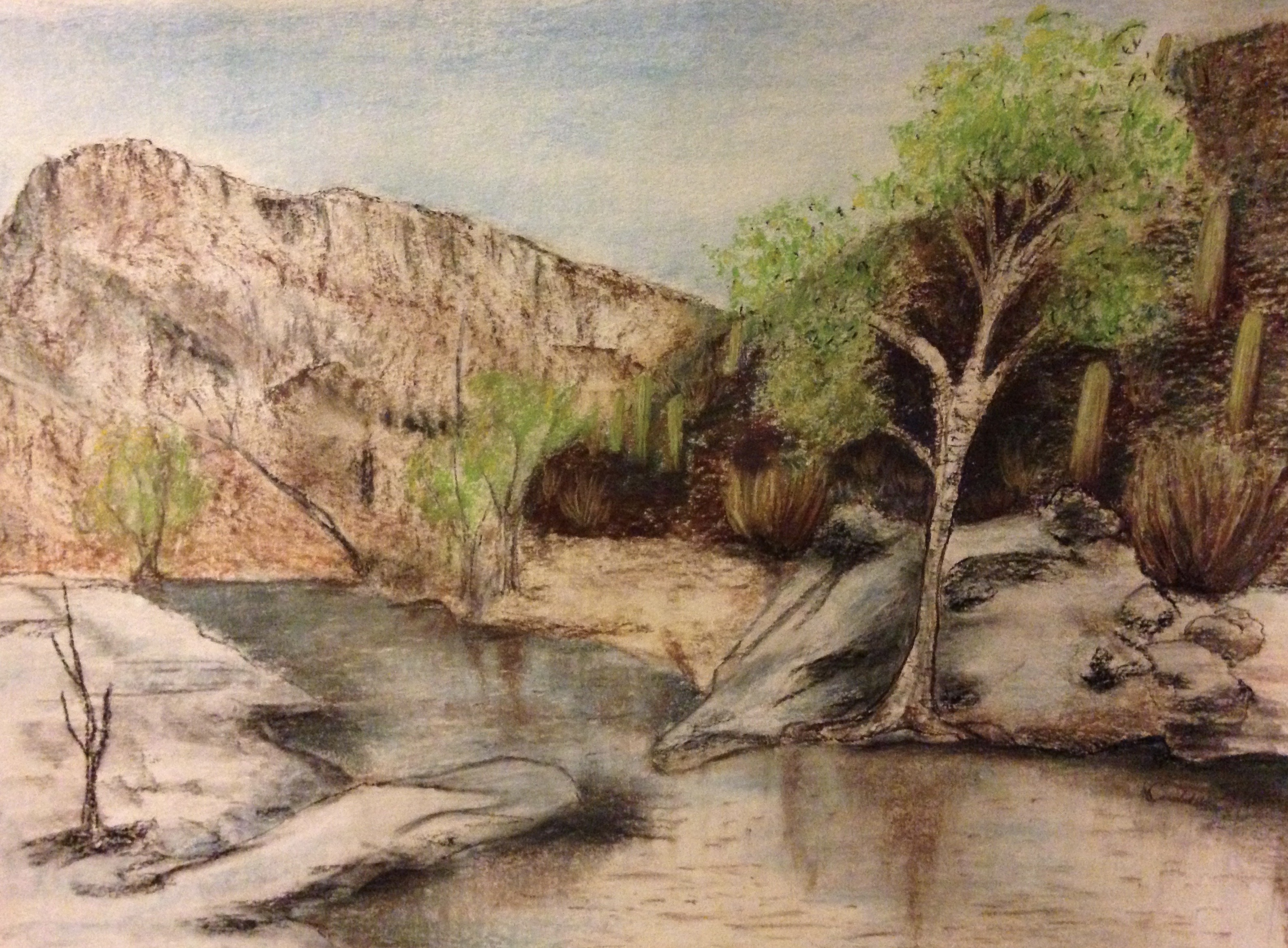
“Sabino Canyon” by Margaret Carlock-Russo
Pastel. 2017.
“Sabino Canyon in Tucson, Az is one of my favorite places. Being surrounded by nature is at once calming and exhilarating. The ever-changing landscape in this canyon never fails to amaze me.”
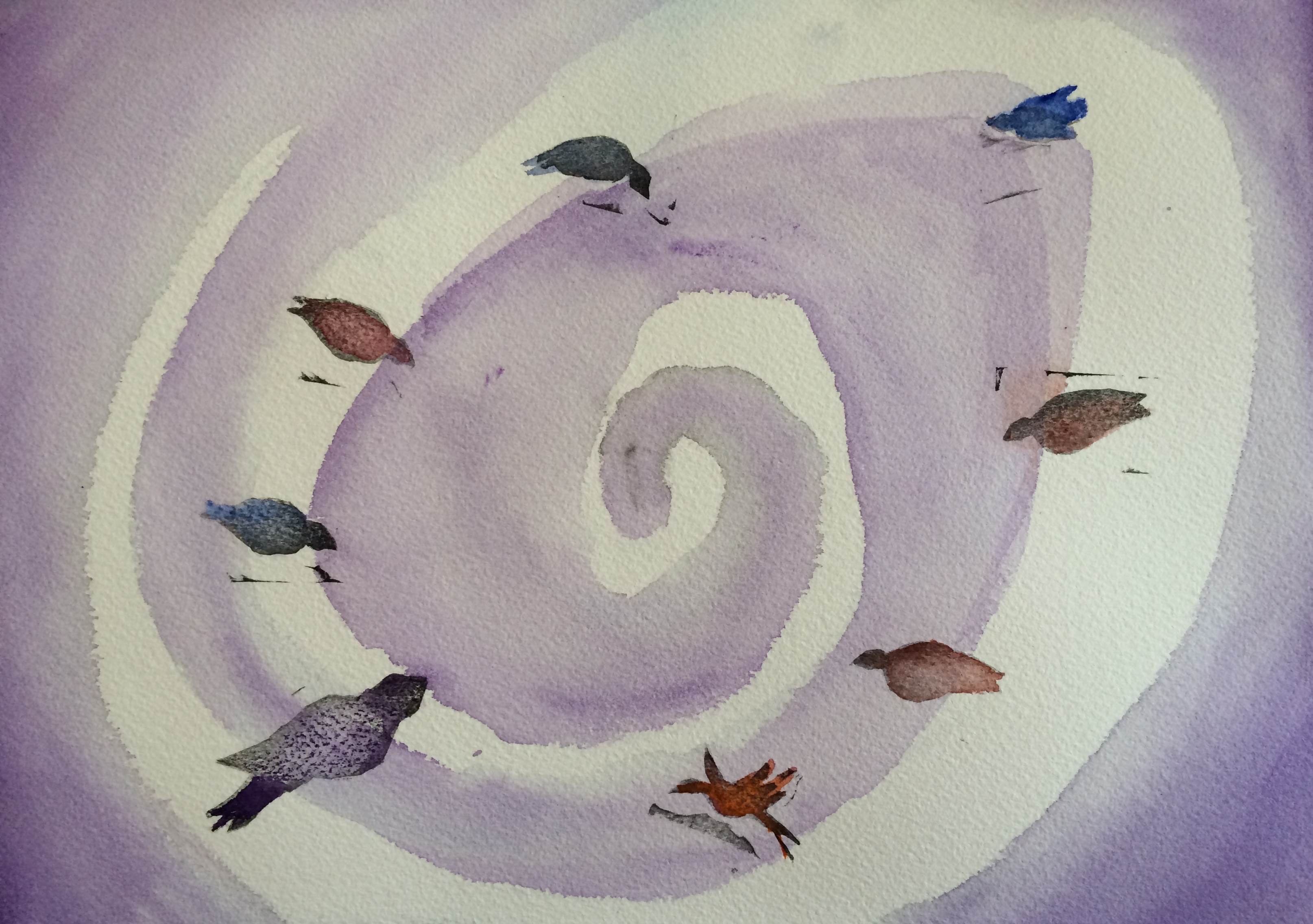
“Supervision” by Barbara Fish
Watercolor, hand cut stamps and ink. 2015.
“I made this piece in response to my fieldwork supervision class. I used watercolor, hand-cut stamps and ink forming each bird stamp to represent a specific supervision group member. The birds perch on a spiral that connects us all. I wanted to represent the energy created and perpetuated by the supervision group. All contribute to the supervision process and are supported by it.”
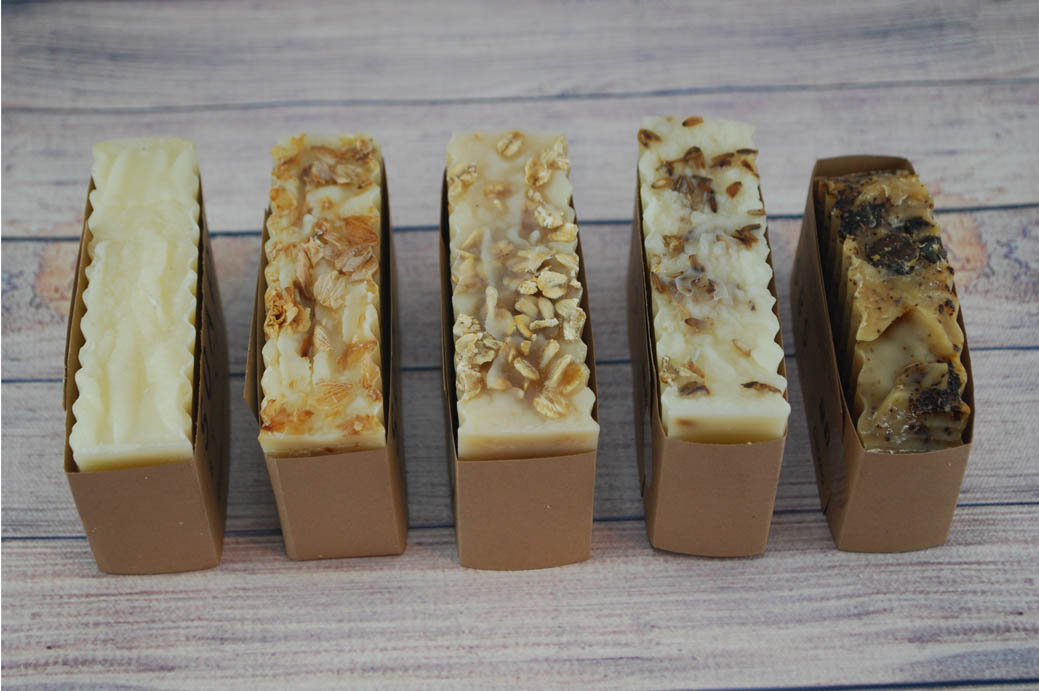
Handmade Soap by Stephanie Clark
Plant based oils, essential oils, and botanicals. November 2019.
“For the past several years I’ve dedicated almost all of my creative energy towards making handmade soap and other bath and body products. I normally consider myself a textile artist. I use natural fibers to weave, felt, or make paper; transforming the fibers into something new and useful, be it a scarf or paper. Soap making is a similar process, with a chemical transformation. You can experiment with different natural oils, essential oils, and botanicals to create something new and nourishing for your body. I love the metaphor of transformation and self-care, and the use of plant based materials.”
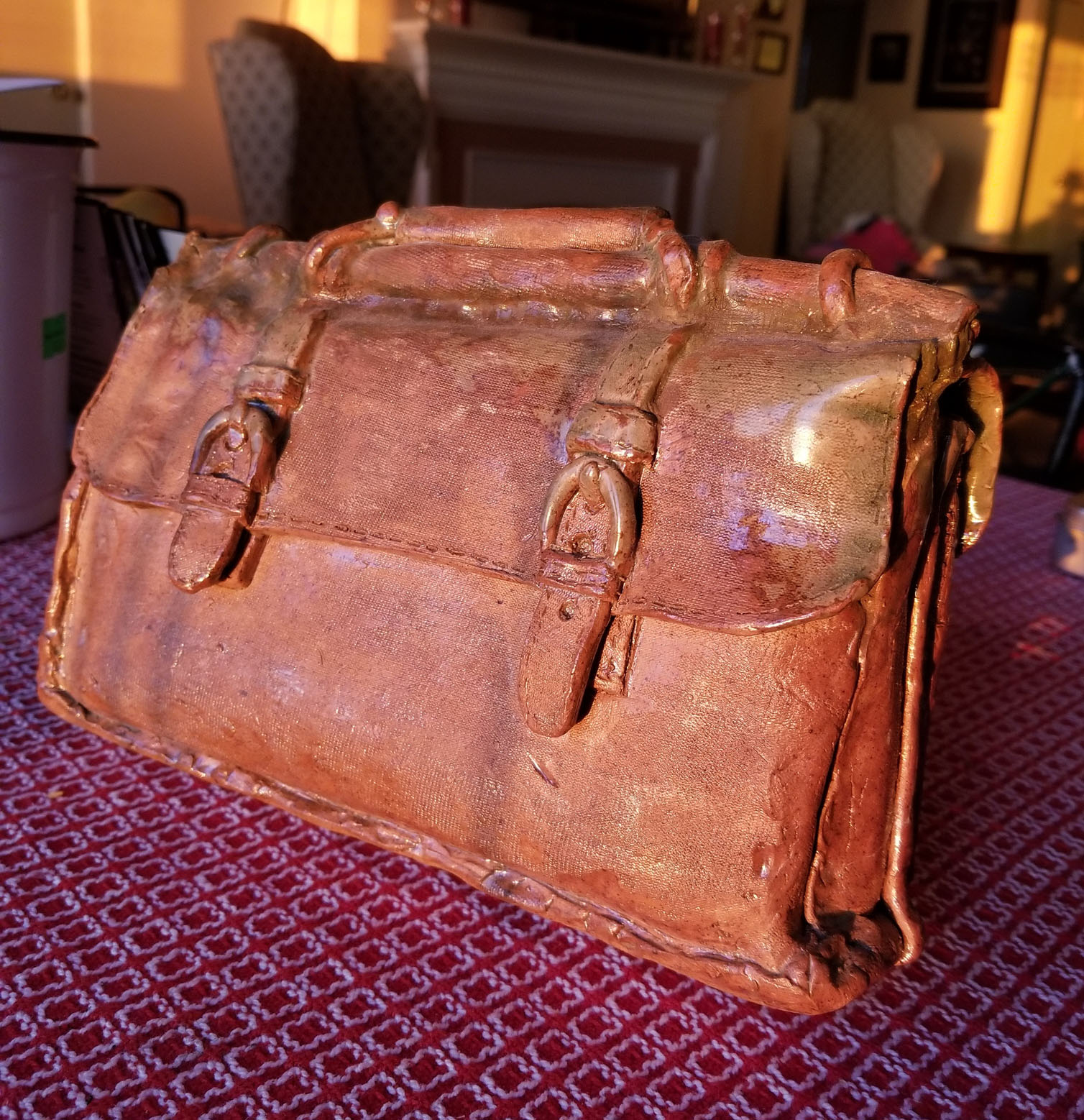
“Torn Valise” by Claudia St Clair
Ceramic created under the guidance of Turner Ozdogan.
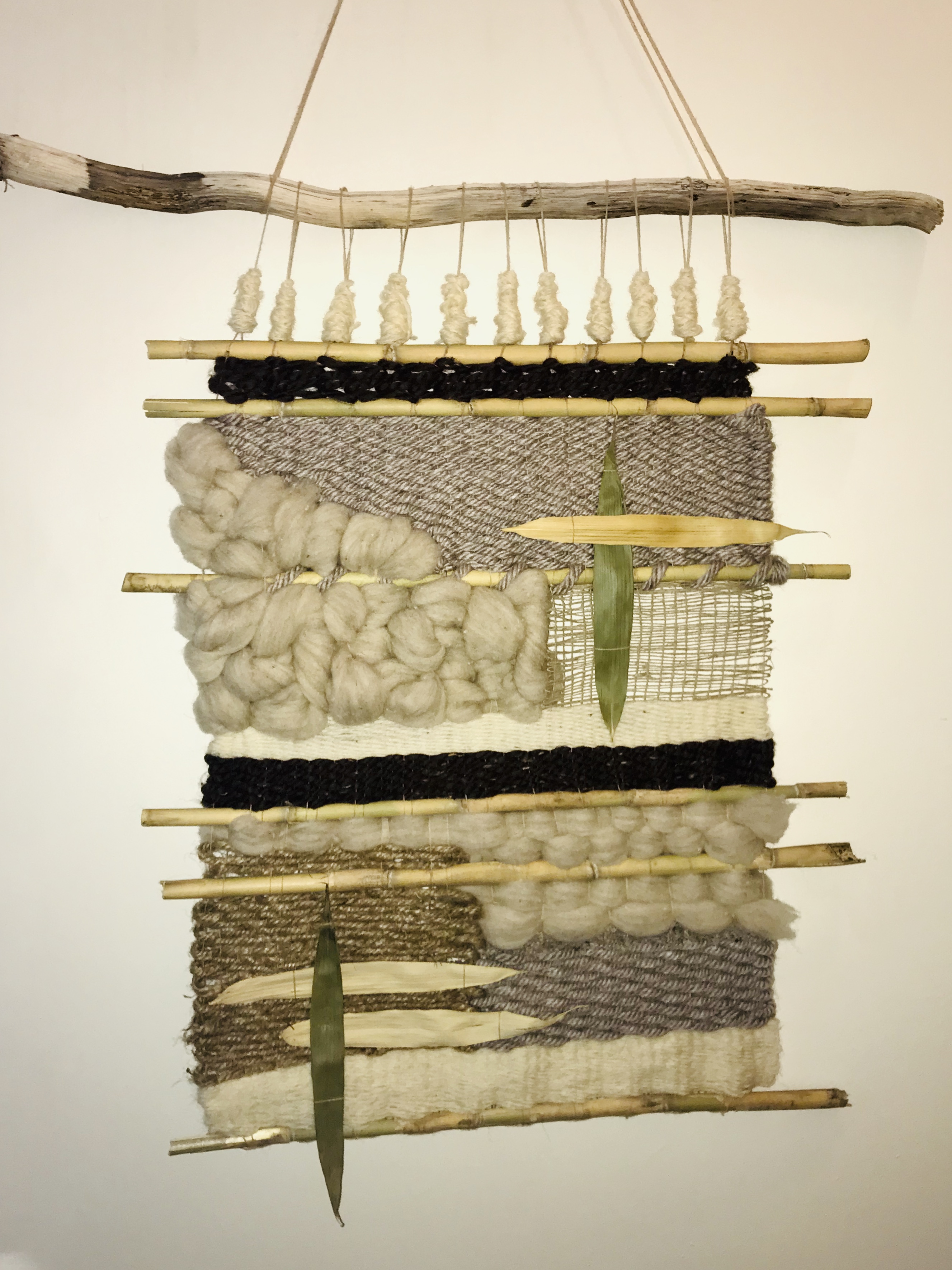
“Documentation of Inspiration” by Marissa Uher
Sheep wool, bamboo, and driftwood. May 2019.
“The weaving represents the development of my artist and therapist identity by using natural materials from two locations which influenced my growth. My artistic interest started to emerge while attending high school in Pennsylvania, where I was able to create a collection of paintings inspired by human animalistic behaviors. I used my paintings as a self-meditative technique in overcoming my own internal struggles.
My interest in the effect of the creative process on mental health emerged and I pursued mu educational career in art therapy. After my introduction to the Ngwane culture, I found a new internal sense of control through the unmediated method of weaving. My personal beliefs and preferences related to the creative process align with the Gestalt theoretical approach. The weaving process allows me to focus on the environmental sensations and current thought processes. My therapeutic work with patients typically provides individuals with the focus on the here-and-now. The development of coping skills through self-meditation has increased my awareness of self and provided me with the opportunity to increase internal sensations of peace.”
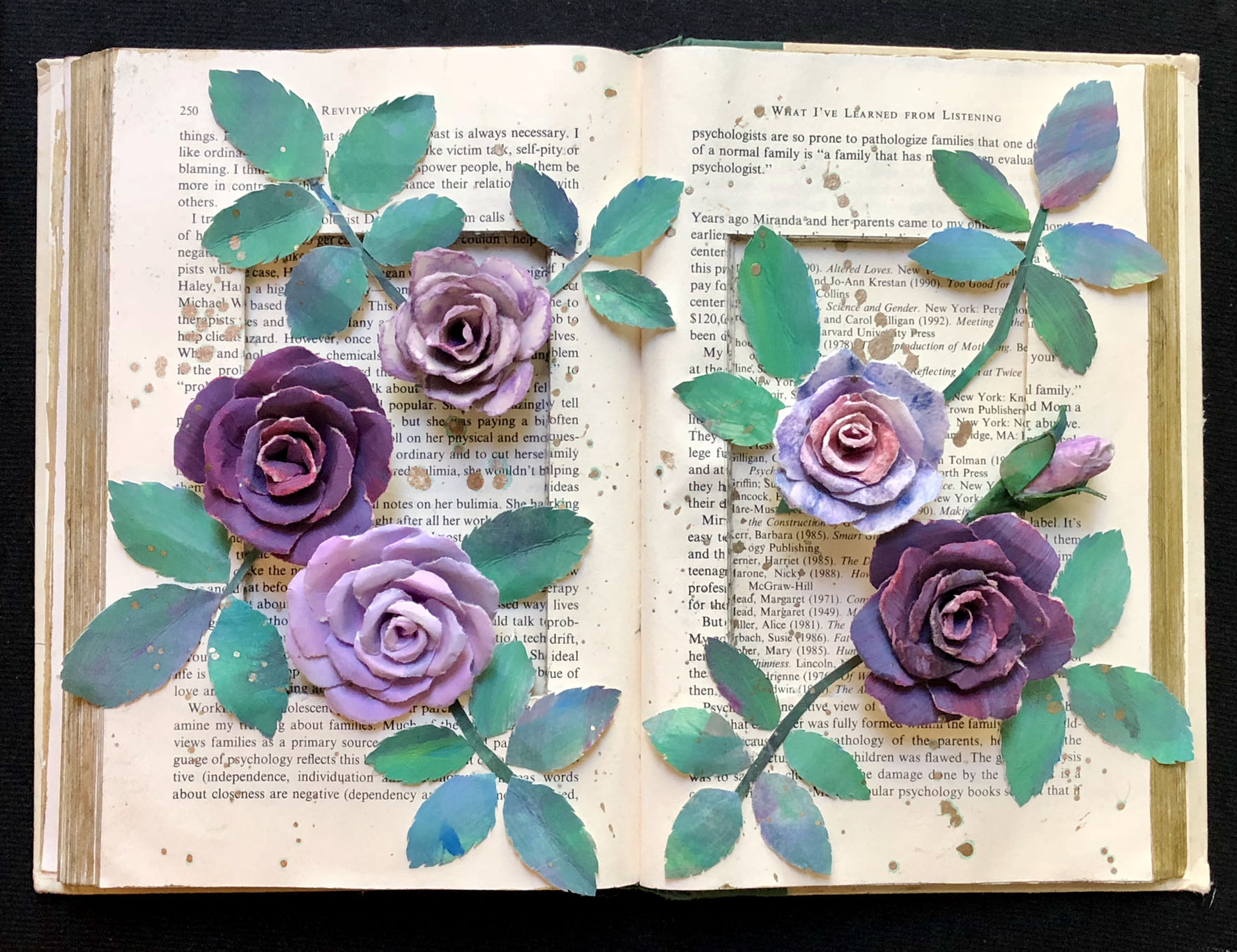
“What I’ve Learned From Listening” by Carolyn Mehlomakulu
Altered book, repurposed acrylic, and tempera paintings. 2018.
“This art piece was created for our 2018 STATA art show around the theme ‘A Compassionate Community.’ In the piece I was thinking about the importance of honoring the stories that have made us who we are. As a therapist, it is so important to really listen to a client’s experiences, to hear their thoughts and feelings with compassion and curiosity, to believe that they can “bloom” and thrive. I was also thinking about my own journey as a therapist, how I have grown and changed over the years, and remembering to practice self-compassion. As part of that, all of the flowers and leaves were created out of previous artworks I had done – both pieces from graduate school and pieces that I had considered unsuccessful for some reason.”
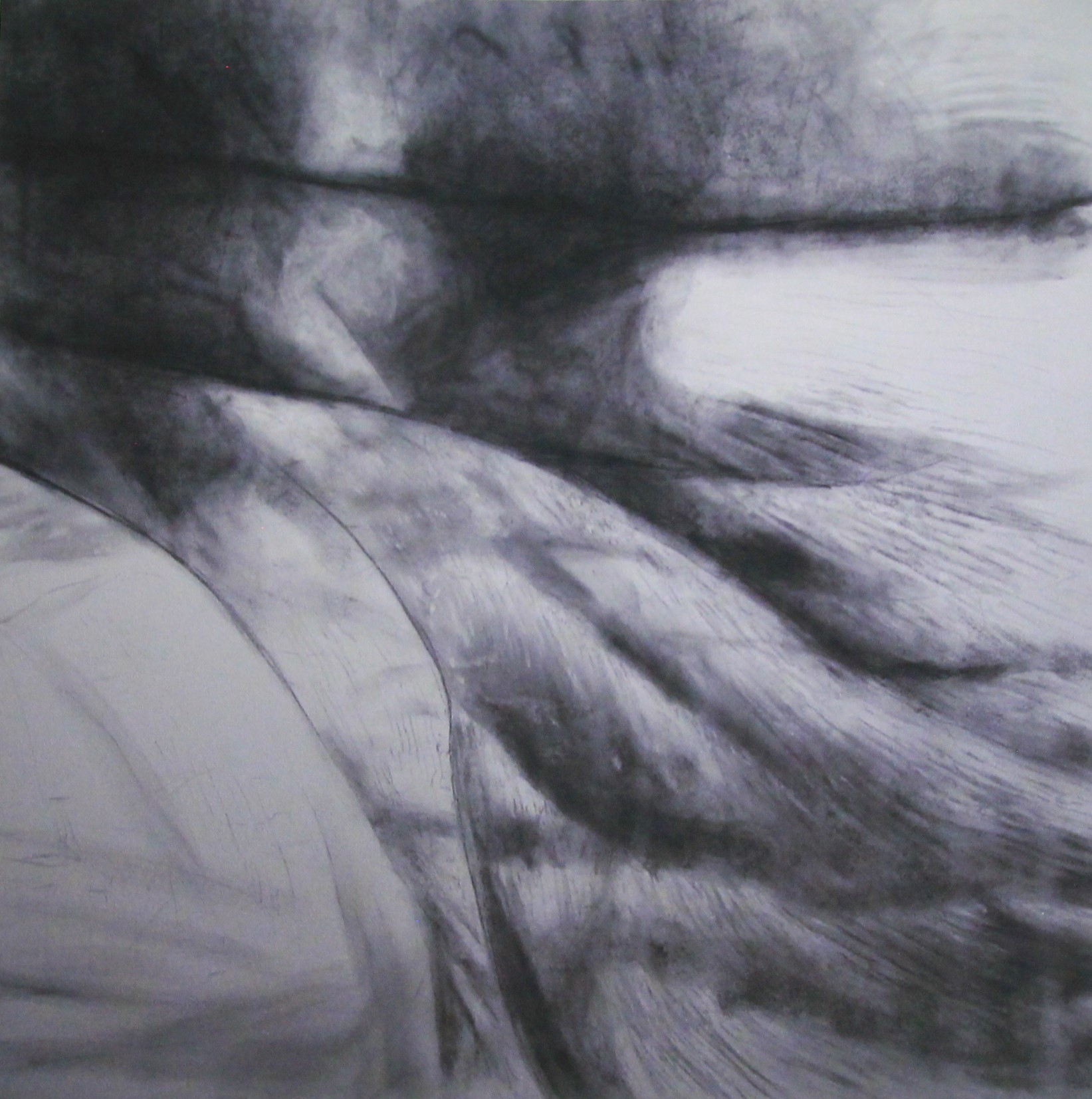
“Life Lines” by Karianne Spens-Hanna
Graphite on board. 2014.
“Moving fluidly between abstraction and realism, my work examines the intricacies of connection, the human body, memory, and our relationship with the environment. Using found objects, organic material, paint, wax, and drawing mediums, I explore the idea of entropy and the transience of our being. By expounding on patterns that are mirrored between nature and our own anatomy, my intention is to show that everything is a degradation of matter and energy and we are part of a deeper quantum network. The core of what keeps me creating is my curiosity around connection; how we connect to one another, with our environment, and to our own existence. Working as an art therapist deepens this curiosity and has instilled a purpose to provide people with the opportunities to experience the transformative, restorative and healing qualities of art. I am a visual artist, art therapist, and singer/songwriter and all these facets intricately weave together to form an interdisciplinary practice that revolves around healing.”
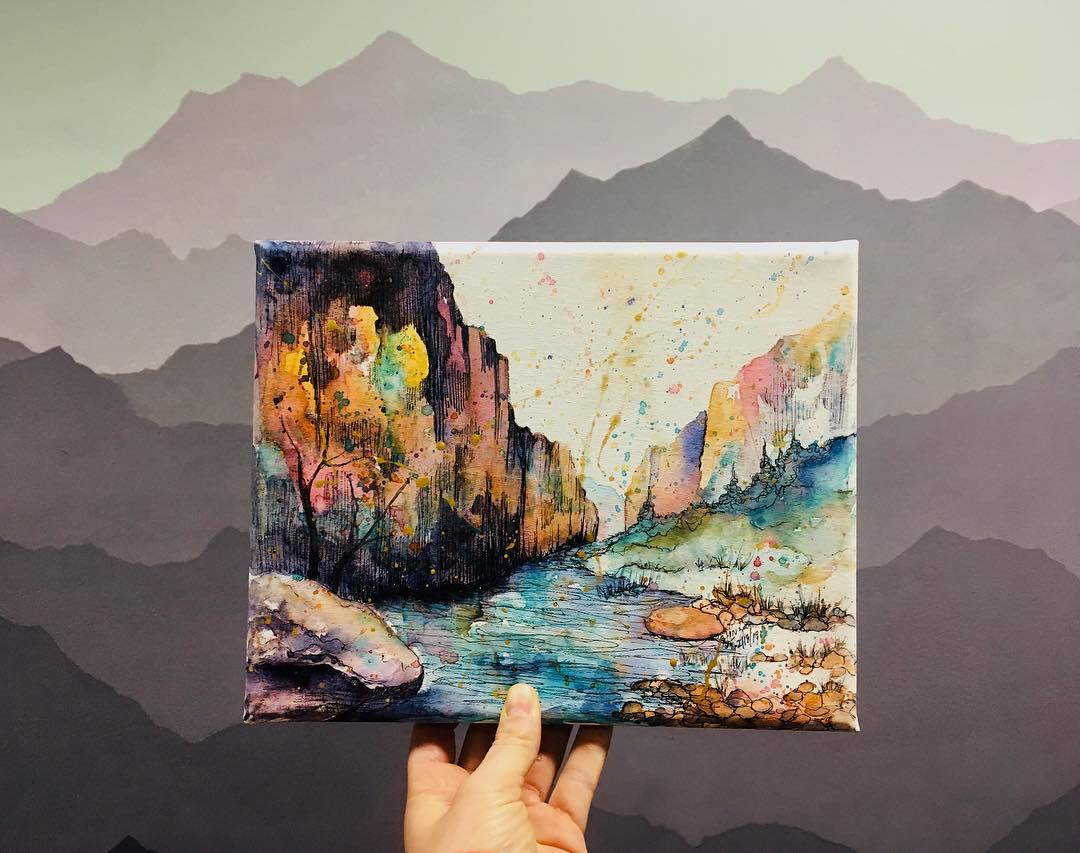
“Zion National Park” by Leara Glinzak
Mixed media. February 2019.
“This piece was painted from a solo trip I took in Zion National Park. As an art therapist and entrepreneur, I have learned my best practice of self care to is going on a solo trip and hiking. At a point where I felt overwhelmed by professional and personal grief and distress, I took a trip in the winter to Zion National Park where I find by listening to Mother Earth She helps me to become reconnected and grounded. My artist style changes depending what is occurring in my life where I found this journey reminded me on the themes of reflection, slowing down and trust. This piece taught me to see the colors and vibrancy in my own life as the colors on the snow reflected it’s surroundings, when I found myself getting too connected to a desire to make the piece have a specific outcome, I threw paint onto the canvas and when it was dried I revisited the piece and re-established the details with various materials. This pieces says to me, ‘Stop. Look around. Otherwise you’re going to miss it.’ This piece and experience reminded me of not only being present with my clients but on the importance of being present in my own personal life so as to not miss the magic in the ordinary and these moments I will never get back.”
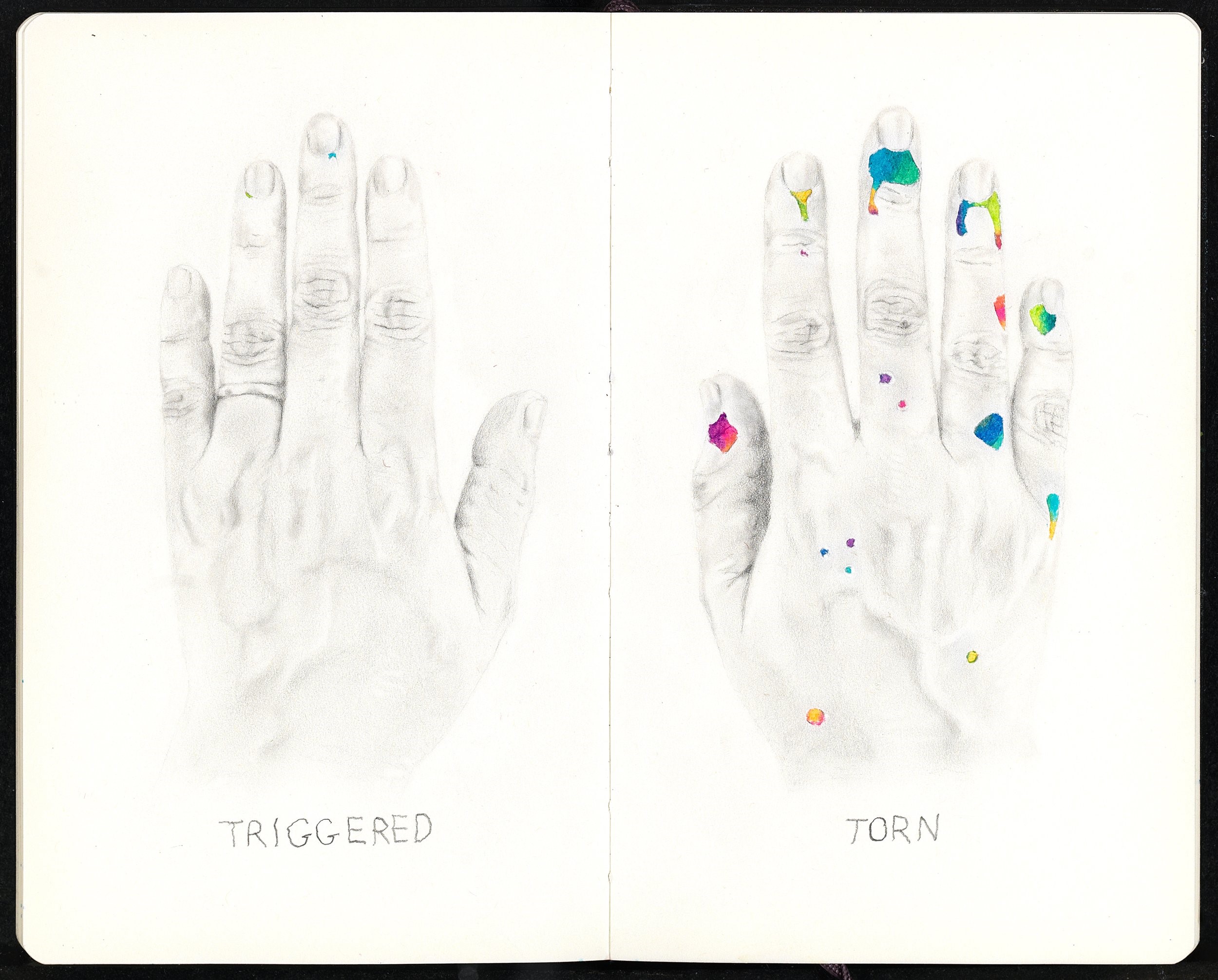
“Repetitive Behavior: TRIGGERED/TORN” by Sondra Rosenberg
Pencils and oil pastels. June 2019.
“This piece is 1 of 6 in a small-scale series that explores body-focused repetitive disorders by depicting fingernails as a site of tension. Through the time-consuming and repetitive act of rendering hands in various states, I am both examining and reproducing the fixation on this small but highly symbolic area of the body. Why do anxieties often find expression in the picking at and biting of nails? Anatomically, our nails function as tools of protection, aggression and fine-motor manipulation. Socially, we maintain and present our nails to communicate how we want to be seen and understood. They become signifiers of gender, class and ideology. The pairs of images in this series emerge from the fraught intersection of instinct and self-management. The drawings mimic simple diagrams while exploring and complicating categories of woundedness and healing, disorder and order, violence and playfulness, compulsion and depletion, self-expression and self-destruction.”

“Release” by Meredith McMackin
Handmade paper with pulp printing. 2012.
“This image was from the memorial service for my son who was killed in Iraq in 2007. It was created during a Peace Paper Project workshop at Florida State University sponsored by the FSU Veteran’s Center. The paper was made from the cloth of the dress I bought for his service, which I could never wear again. Cutting the dress into small squares, I released them into water which fed into a machine that slowly ground the fibers down to pulp. I felt a sense of ease and release watching the fibers dissolve the tightness of painful memories and float freely in the cleansing water. The image was created by ‘pulp printing’, spraying fine dyed cotton pulp through a photo stencil; his flag-draped coffin representing the personal cost of war. The finished piece symbolizes my son’s release into spirit as well as my own transformation inspired by his self-less gift of life.”

“Badlands Storm” by Susan D. Loesl
Acrylic paint. 2018.
“I am fascinated by storm clouds with their quickly changing colors and forms as they build up across the sky. Watching this cloudburst approach across our path as we were driving through South Dakota was one of the most significant storms I have seen. To this day, the power of this storm still has an impact on me.”
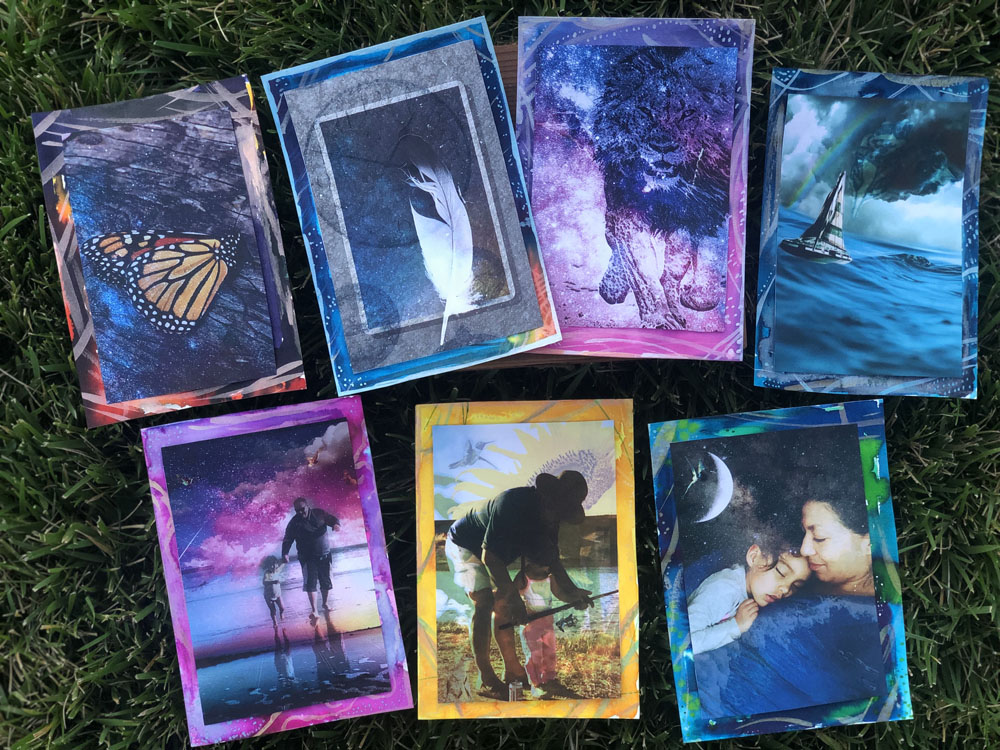
“Gifts from the Sky” by Melissa Contreras-Walter
Mixed Media 4×6 cards on watercolor paper. 2018.
“When my grandfather was diagnosed with cancer my family and I were devastated. Art was the only way for me to process such an emotional time. I made more art than any time in my life. While sitting in the waiting room, after a long day of caring for many family members during this journey and when I was able to reconnect with nature I would create art in some way. These cards are made up of personal photographs created into digital collages with painted backgrounds. My cards symbolize of what I needed most and as reminders of what I have.”
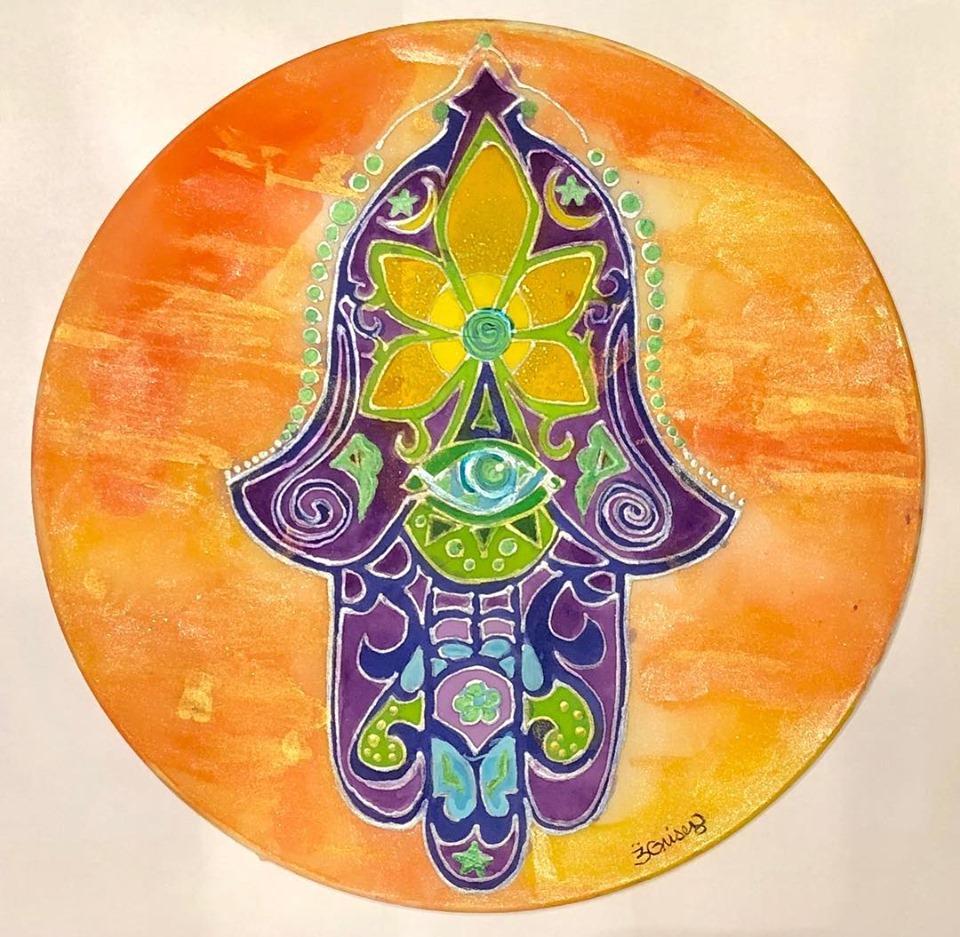
“Unselfishness” by Janeane Grisez
Silk mandala painting. 2019.
“I create the silk mandalas as an act of self-care to process my day after providing art therapy for my clients. I choose the mandala as it is a container for my feelings, a center point for my process, an ongoing spiritual guide in the work that I continue to do. The silk absorbs the paint, as it absorbs my thoughts, feelings and letting go, unselfishly, so that I might be refreshed to give again.”
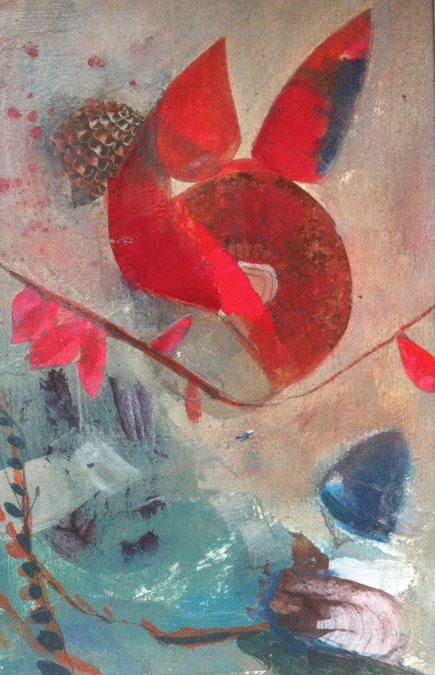
“Tightrope” by Pooja Bakri
Acrylic, collage and ink on paper. 2017.
“Memory is a focal point for much of my work as an artist and art therapist. I am interested in memories that we experience first-hand, as well as memories that are passed down to us. My creative process involves the layering of imagery and mediums. Patterns and symbols are often erased and distorted, while always building over a foundation of what has come before. Some characters are clear and in the foreground, while others are muted and pulse beneath them. It is this process that aids in giving visual form to the complex and ephemeral act of recollection.”
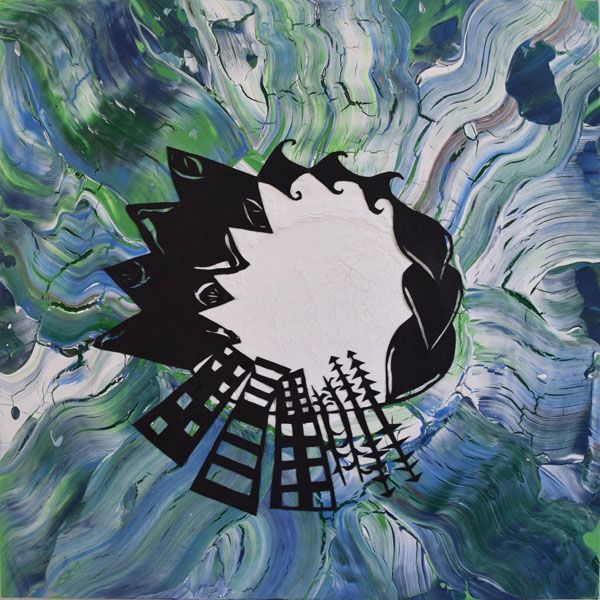
“Tension of Home” by Megan Gunkel
Acrylic paint on cardstock. January 2018.
“As I create, I am influenced by the nature around me in Juneau as well as scenes from different places I have lived or traveled. My artwork consists of themes regarding human nature, commonalities in the human experience, and serves as a type of visual journey of my life. When I create, I desire to make pieces that will resonate with others and create connection between the viewer and the art, or spark a conversation among viewers. I believe my desire to connect with others through my work is part of what led me to the profession of art therapy, as it is a venue where art connects the client and therapist to promote healing.”
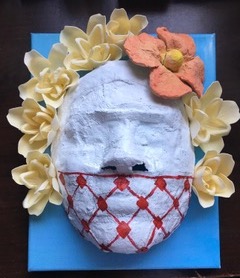
“Coverage” by Iman Khatib.
Mixed media. 2017.
“My voice is amplified by the layers of my identity. A Muslim, a woman, a Palestinian-Malaysian. I find strength and guidance through my heritage and this mask provides coverage from hatred and animosity. In my work as an art therapist, I strive to recognize and support the layers of identify within every client. Together, we discover the path towards well-being.”

“Mākua” by Lauren Kim.
Acrylic paint on canvas. 2017.
“Mākua valley, located on Oʻahu, Hawaiʻi, was a vital docking point for canoes in ancient Hawaiʻi, and opened to vital fishing grounds. It was and is still a sacred place for Native Hawaiians. Sadly, during WWII, Mākua valley was (and continues to be) occupied by the U.S. military as an ordnance testing site. The destruction of Mākua valley left ancient temples, fishing shrines and wildlife desecrated. Though the military has not conducted live-fire exercises in Mākua valley since 2004, the valley remains full of unexploded ordnances.
As an art therapist, I hope to act as the mountains that protect and surround a valley; providing a space for safety, acceptance, nourishment, and growth. Like the clients I work with, Mākua survived extensive trauma yet it still stands and continues to flourish today.”
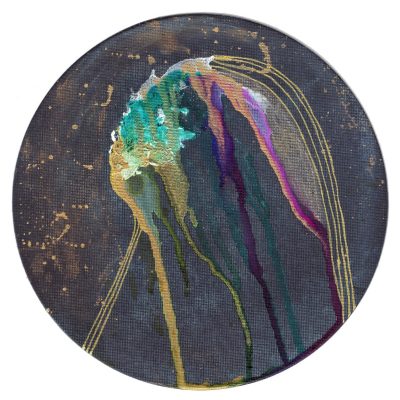
“Untitled” By Annie McFarland.
Alcohol ink and metallic pen. 2018.
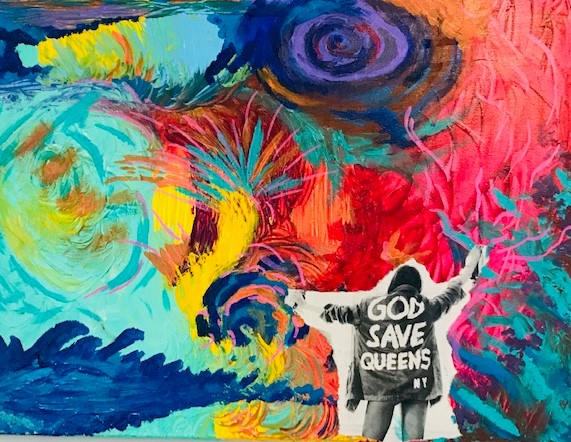
“Needing a Home” by Michelle Anne Hololob.
Mixed media.
“This is a response piece to the continued frustrations dealing with my patients suffering with the broken shelter system. More and more people are coming in dealing with homelessness, and, as a therapist, it is hard not to feel powerless at times. I painted with acrylics, dispelling some frustration and finding it unfinished, found the collage piece that seemed to contain all that energy.”
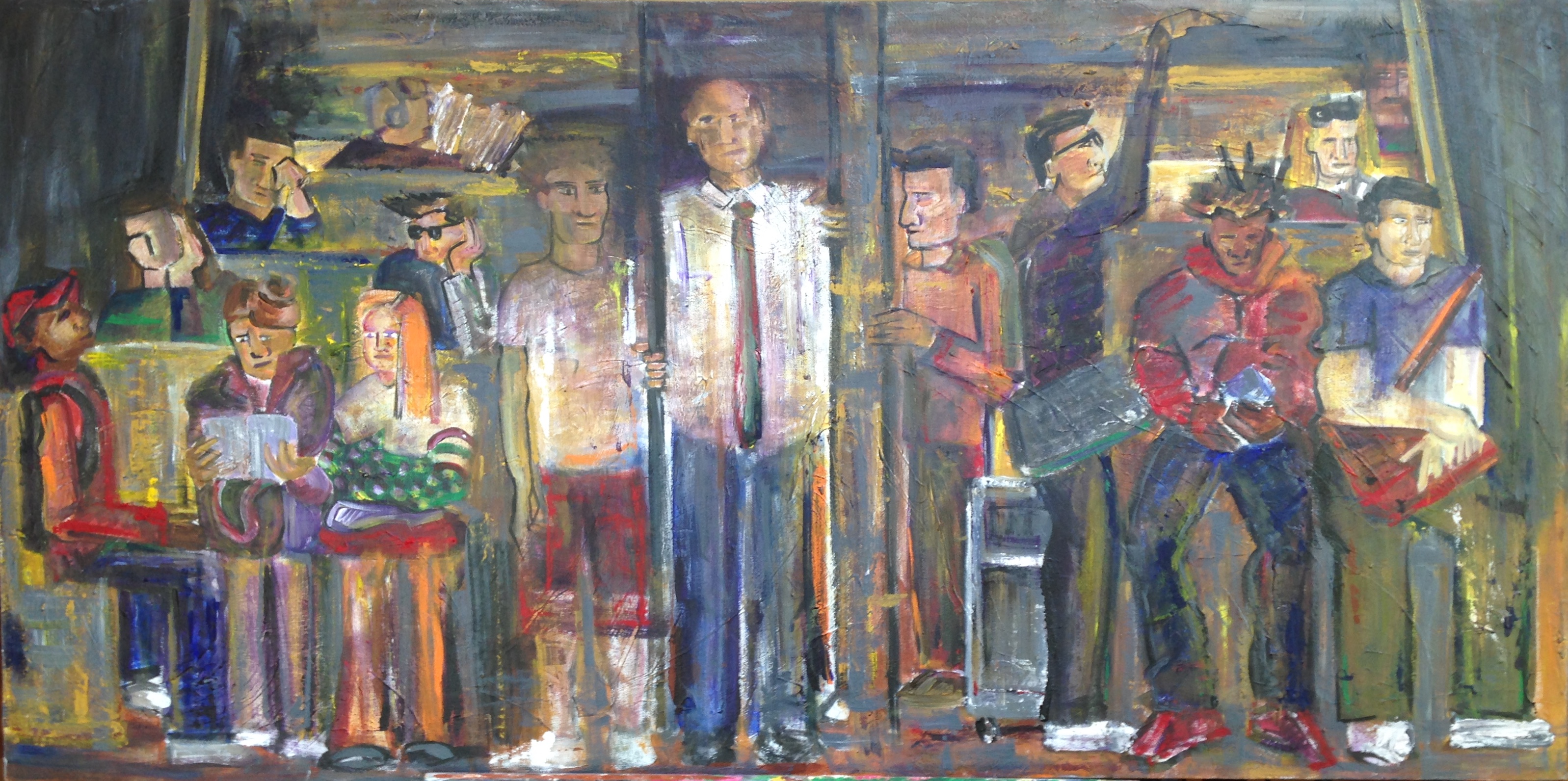
“Metro Riders” by Jordan Potash.
2018. Acrylic on canvas.
“I started sketching people in public places as a way to pass the time and liven up an otherwise dull commute. What I found was that I developed a remote sense of intimacy with each subject. Public transportation is an odd space in that we all share it, but try our best to interact with others as little as possible.
This scene comprises several sketches from my commute over months. I sketched some of the individuals for almost a full commute, while others were only on the train for a few stops. Even though I do not know anything about any of these people, as I reviewed my sketches and translated them to the canvas, I felt as if I was painting the portraits of long forgotten friends.”

“Ruby” by Kortney Malone.
From nursing home portrait series. Pastel on paper. 2004.
“As an artist, my creativity is my voice. It sustains me mentally and emotionally in my best and worst moments. Growing up and in my adulthood, I often find art is my free space in life where I can recharge and gain self-awareness, have a window into myself where I choose to be at ease or be challenged, but ultimately art making for me is a place of change to use to connect with others.”

“Staying Afloat” by Ashley Rivera.
February 2018. Tissue paper, water-soluble oil pastels, yarn, and cardboard.
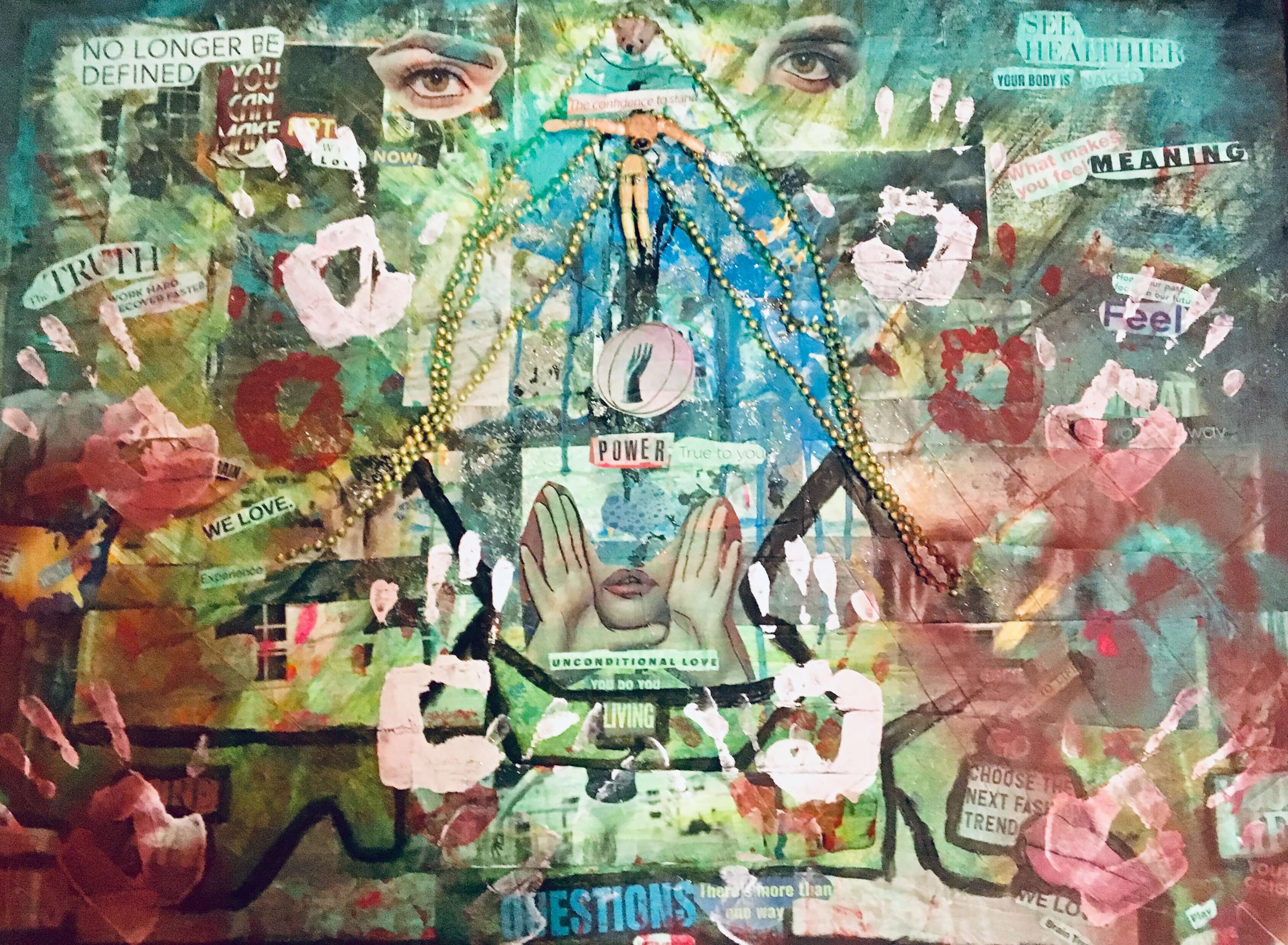
“I Am Enough” by Trica Zeyher.
Mixed media. January 2019.
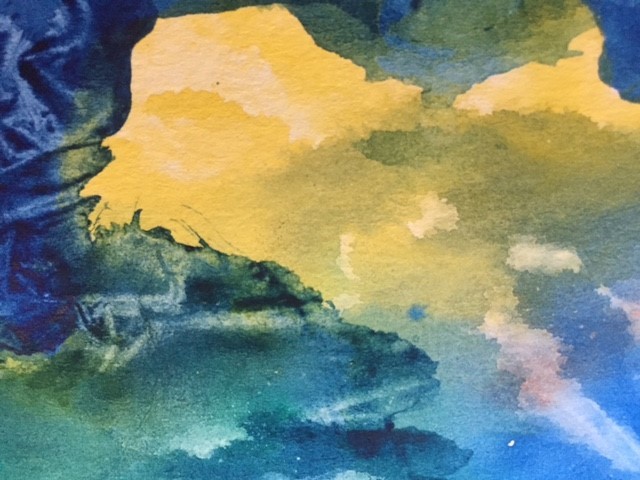
AATA 2018 Conference Logo Artist Contribution by Nina Hausfeld.
“This watercolor was created during a demo for one of my art groups. The technique we used incorporated wet on wet watercolor painting and plastic wrap. This technique allows for the beautiful blending of colors while also making space for the emergence of the unintentional and often surprising shapes, marks and patterns left by the lifting of the paint by the plastic wrap.
In a sense, this process invites us to be completely present and intentional while also letting go of control and trusting in the power of the creative process to reveal to us it’s beauty and meaning. I find that the approach required to complete this project is a wonderful metaphor for approaching life in general: maintaining presence in the face of the unknown and trusting in the outcome.”

“The Struggle” by Charles Anderson.
Acrylic Painting.
“The sun represents the overpowering pressure of opposition. Notice the arms and body postures for some individuals in the painting as they enter the struggle. One individual is about to overcome and in the process begins to sink into the earth. Another individual notices the person sinking and prepares to help the individual from sinking deeper.
Each individual in the picture represents many individuals who will one day overcome their struggles, but the impact leaves a sting that changes their view. A view of how they see themselves and the world around them for they will never be the same.”

“Untitled” by Christianne Strang.
2016. Mixed media/watercolor.
“I’m able to create art fairly frequently. Most often I use a mixed media technique that I call reverse coloring. The first layer is wet-on-wet watercolor that, when dry, can serve as the basis for a design. It can be as simple as outlining the gradations of colors to create an abstract design – a doodle that results from the outlining of colors instead of coloring in the lines.”
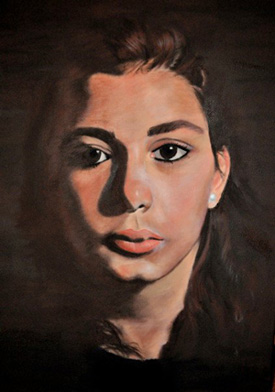
“Self-Reflection" by Kyla Berry
2011. Oil painting.
“As an artist, one of my favorite things to do is to create self-portraits. It’s interesting to see how my style and interpretation of myself change over the course of time. Progression is such an integral part of therapy, so creating art about me helps me as a therapist and challenges me to think about what clients might feel if presented with a similar directive.”

“Family Portraits" by Kimberly McGhee
2018. Acrylic on canvas.
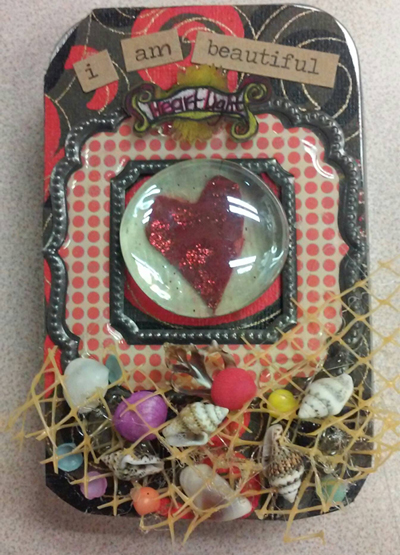
“The Tractor" by Peggy Gulshen
2017. Mixed media.
“I am partial to collage and mixed media because I utilize these materials so often with my clients. “The Tractor” allowed me to revisit a childhood memory and to reframe it in a more self-empowering way.
The smallness of the tin has a secret treasure-feel about it. The altered tin holds my reconstructed memory safely…and tenderly.”
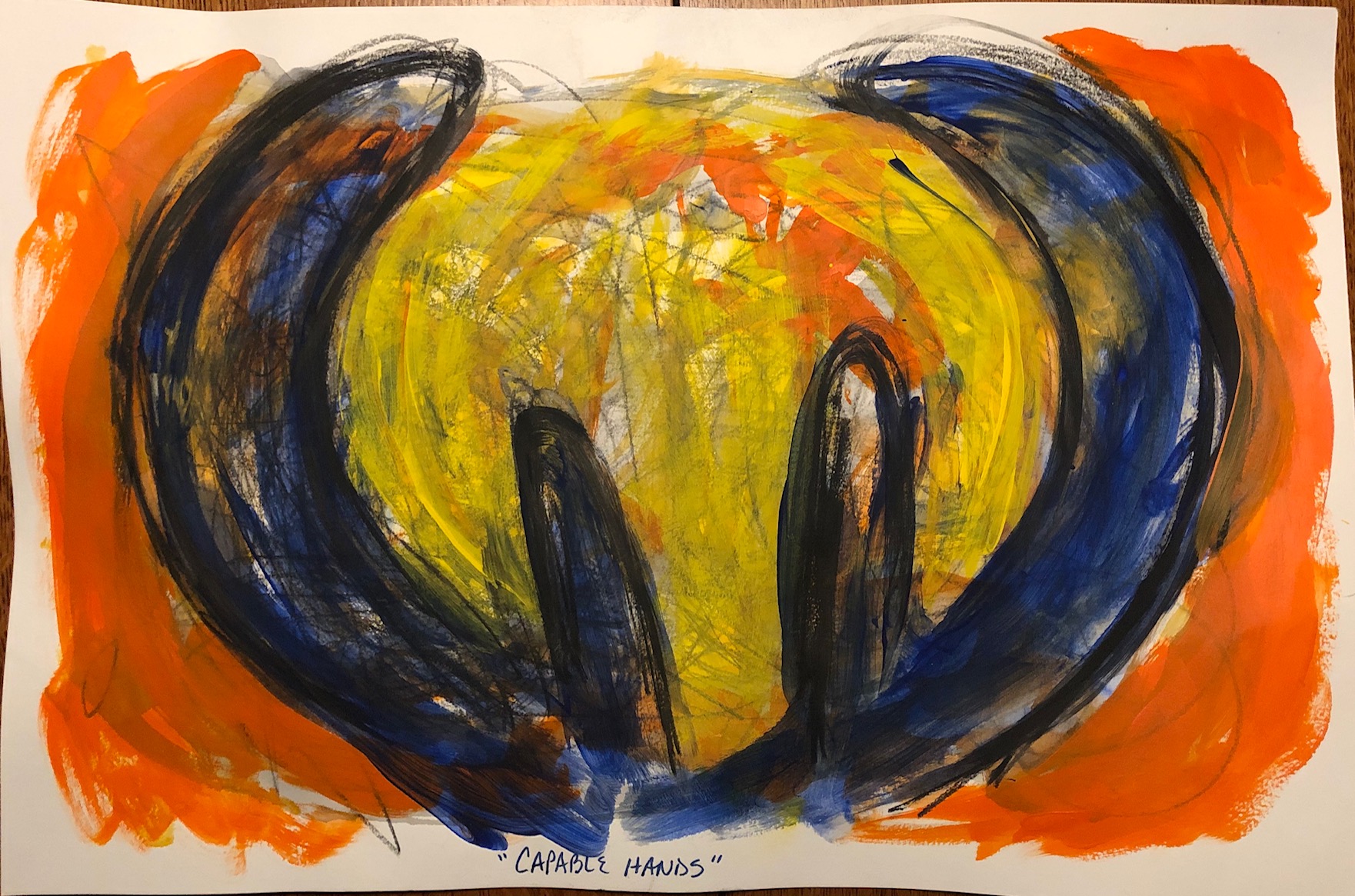
“Capable Hands" by Lisa Lounsbury
January 2019. Acrylic and graphite on paper.
“This art piece was made during our first Focus Group on Maggie and as I was trying to keep all the pieces together, facilitate the group, and not freak out about the things that had gone wrong before people showed u., I could see the image of hands appearing around the chaos. I immediately brought them out more with color and felt like I was being held by the strong, capable hands of my Creator and I could rest.”
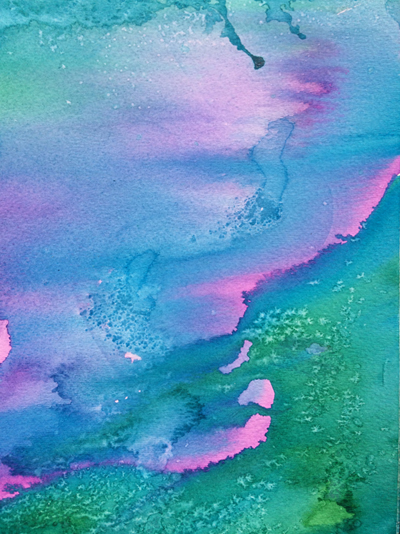
“Untitled" by Phoebe Whisnant
December 2018. Watercolor.
“In recent years I’ve gravitated towards watercolor painting as a mindful self-care practice. I find that focusing on the way the colors mix together and flow across the paper keeps me grounded in the present moment. I enjoy letting go of expectations and seeing what unfolds.”
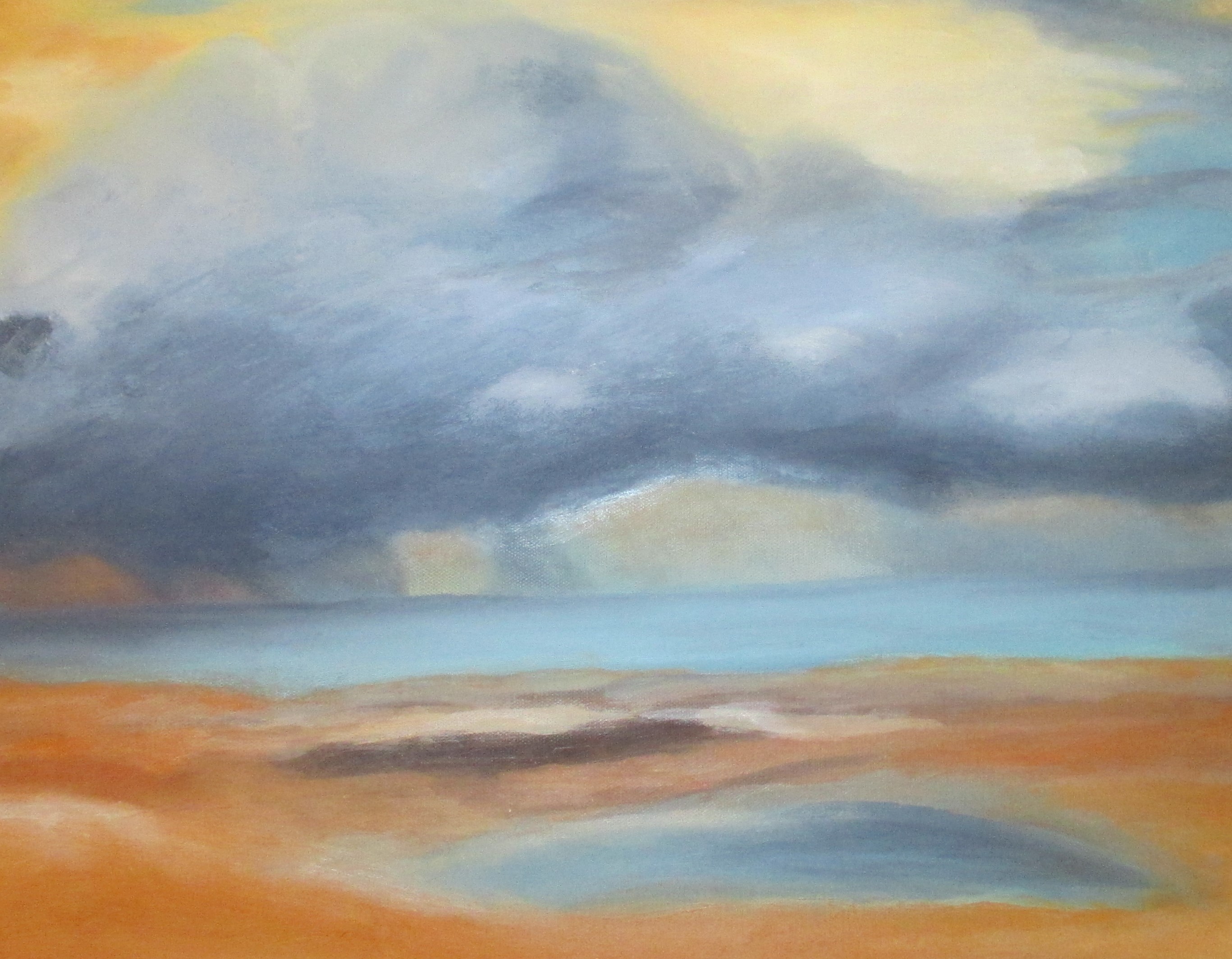
“Degas's Beach" by Lynn Cukaj
2015. Oil paint.
“In honor of Edgar Degas. The serenity and peacefulness of the ocean is balanced with the incoming storm cloud. This piece was part of a juried art show, ‘Up Jumped Spring’ hosted by New Rochelle Council on the Arts in 2017.”
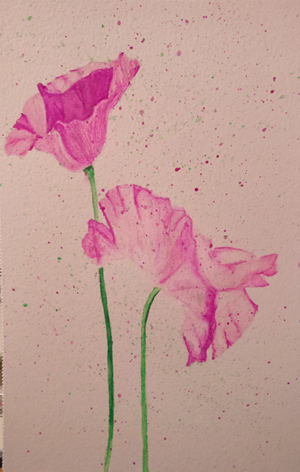
“Growth Particles" by Tracy Weitkamp
2017. Watercolor.
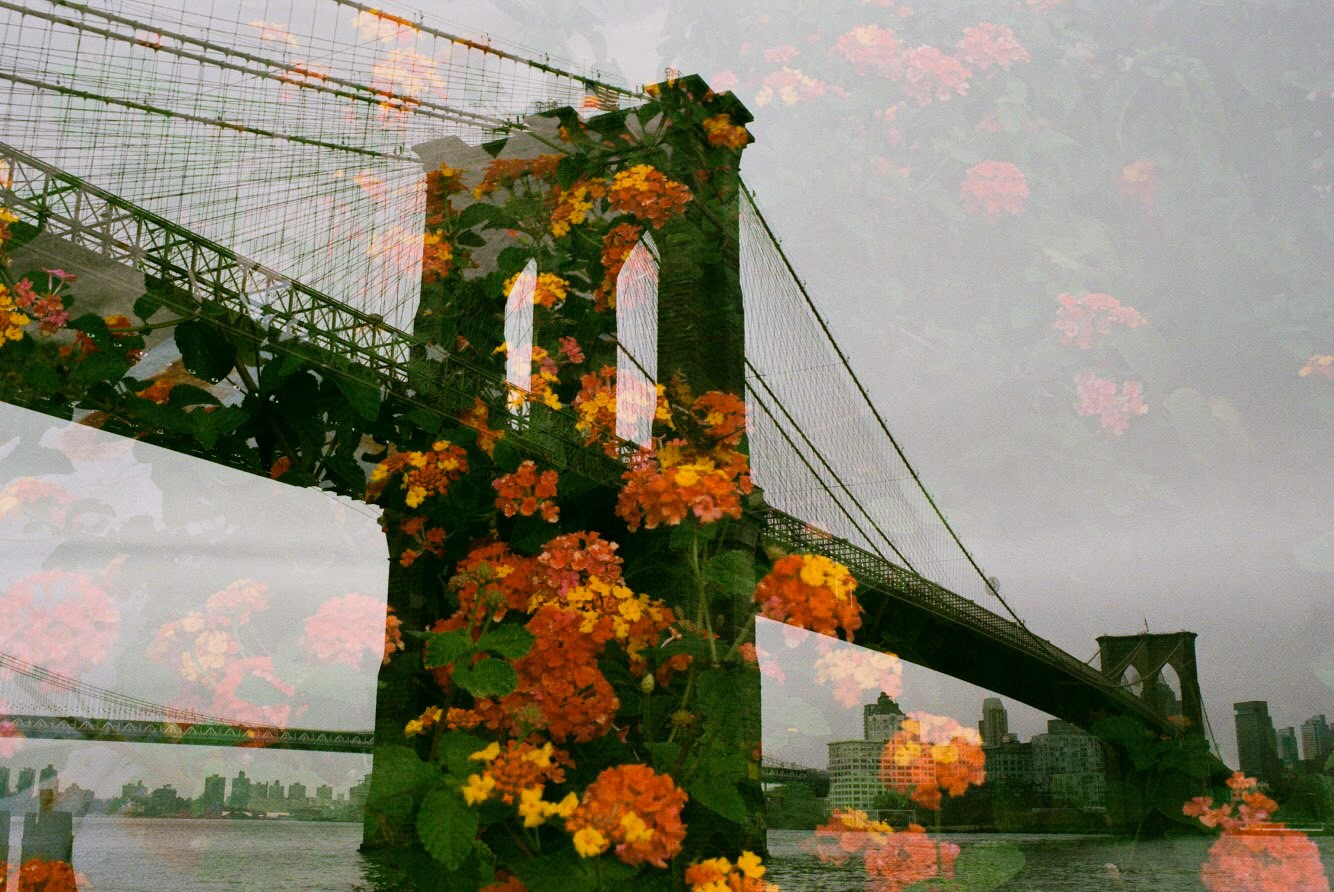
“Beautiful Reach," NYxGA DEF Project by Rob Belgrod
January 2019. Double-Exposed Kodak Gold 200 film.
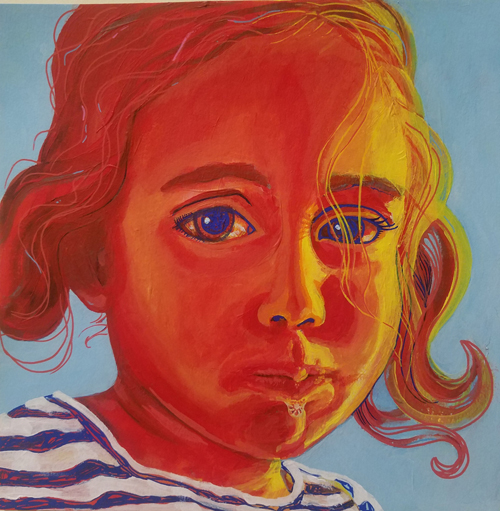
“Water Break" by Melissa Fannin
March 2018.
“A painting of my daughter taking a drink of water on a hot day.”
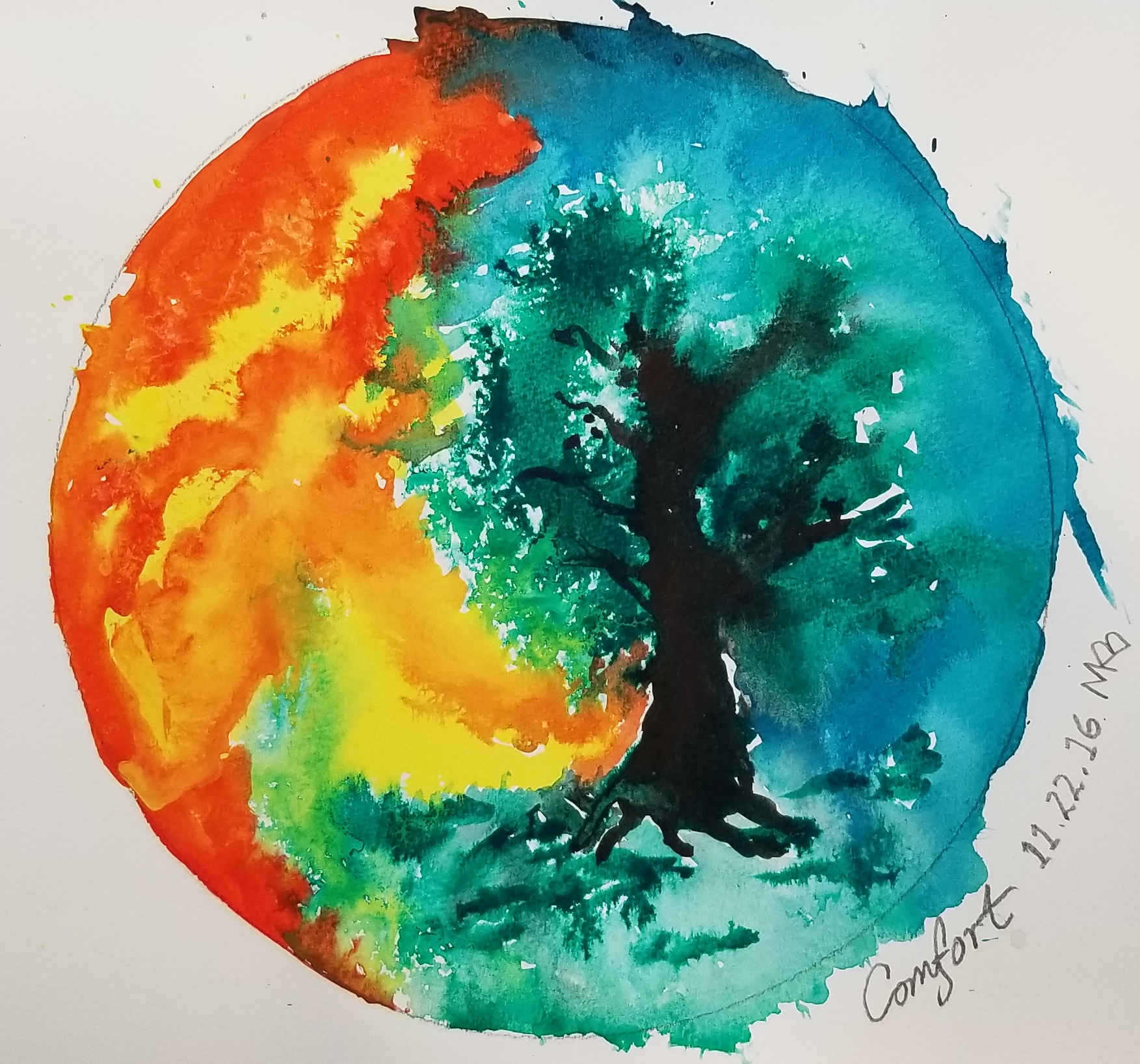
“Comfort" by Mollie Borgione
2016. Watercolor.
“I realize as I look at this now, that to people on the West Coast, ‘Comfort’ may not be their title of choice for this watercolor. However, this painting began as random colors being dripped into a circle. As the colors ran together, a tree began to emerge, and I elaborated on that. I see it as a Yin and Yang balance of intensity and coolness, passion and peacefulness, destruction and growth. That opposites can coexist in the same space brings me comfort.”
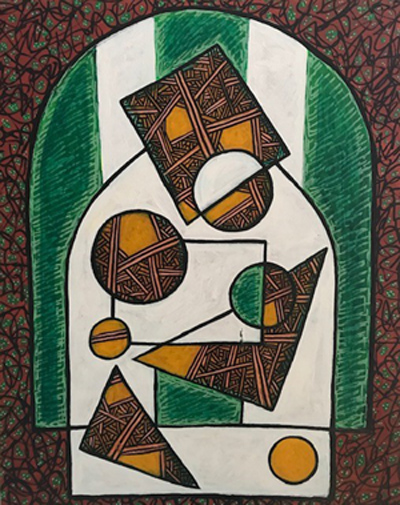
“Archways" by Julia Culkin
January 2018. Acrylic paint.
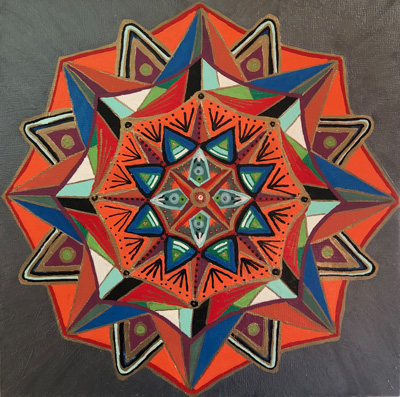
“Evolution" by Laura Bauder
May 2018. Acrylic paint.
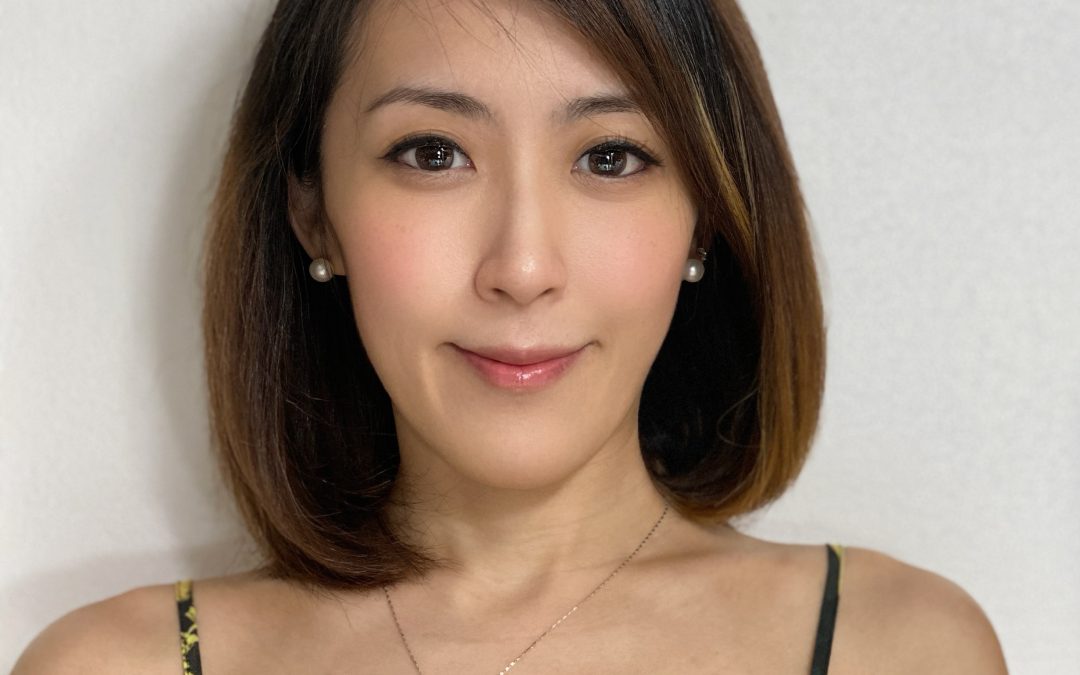
Featured Member: Helena Ma
“I decided to volunteer as a conference local arrangement chair because I wanted to give back to the art therapy community and contribute to the growth and advancement of our field. Being part of the AATA community allows me to connect with like-minded individuals, engage in meaningful discussions, and collaborate on initiatives that aim to move the art therapy field forward.”
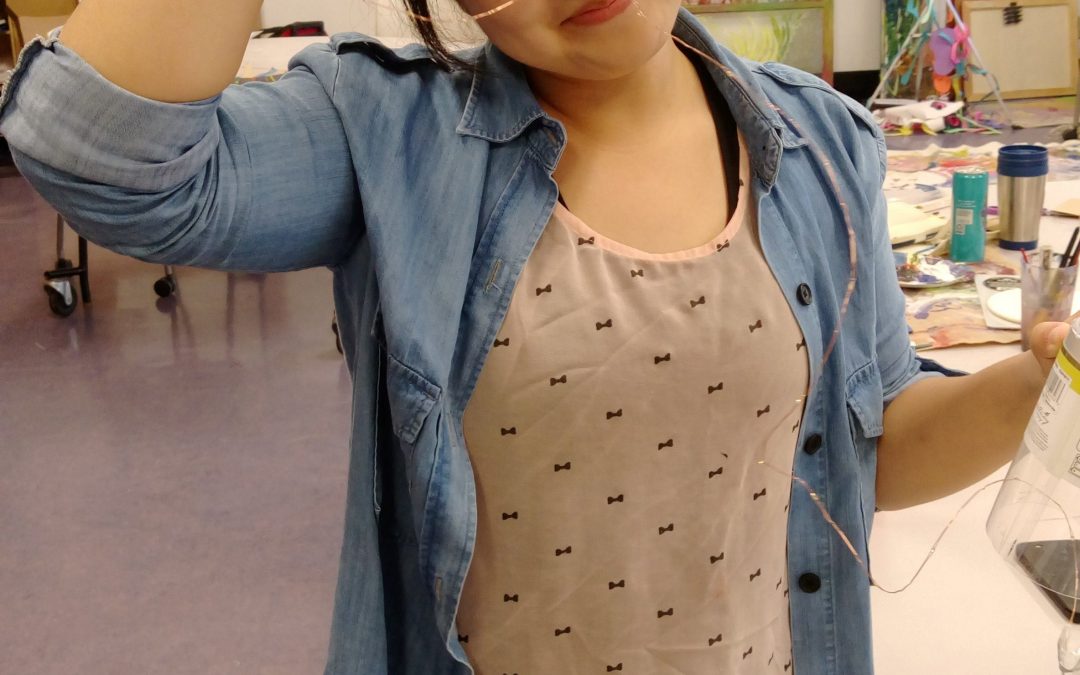
Featured Member: Kai-Ying Huang
Art therapy is still a young profession in Asia. I had never heard about art therapy or anyone with expertise in using art to help people heal until I was in my second year of college. I chanced upon a Taiwanese art therapist who was invited by my professor to share her clinical experiences. As an audience member, I had tears in my eyes and was full of feelings of sadness and love.

Featured Member: Massami Ichikawa
Understanding our own cultural influences is essential in appreciating the diversity of our clients and their cultural backgrounds. Art provides a means of exploring and celebrating these differences, allowing us to connect with others and understand their experiences more deeply.

